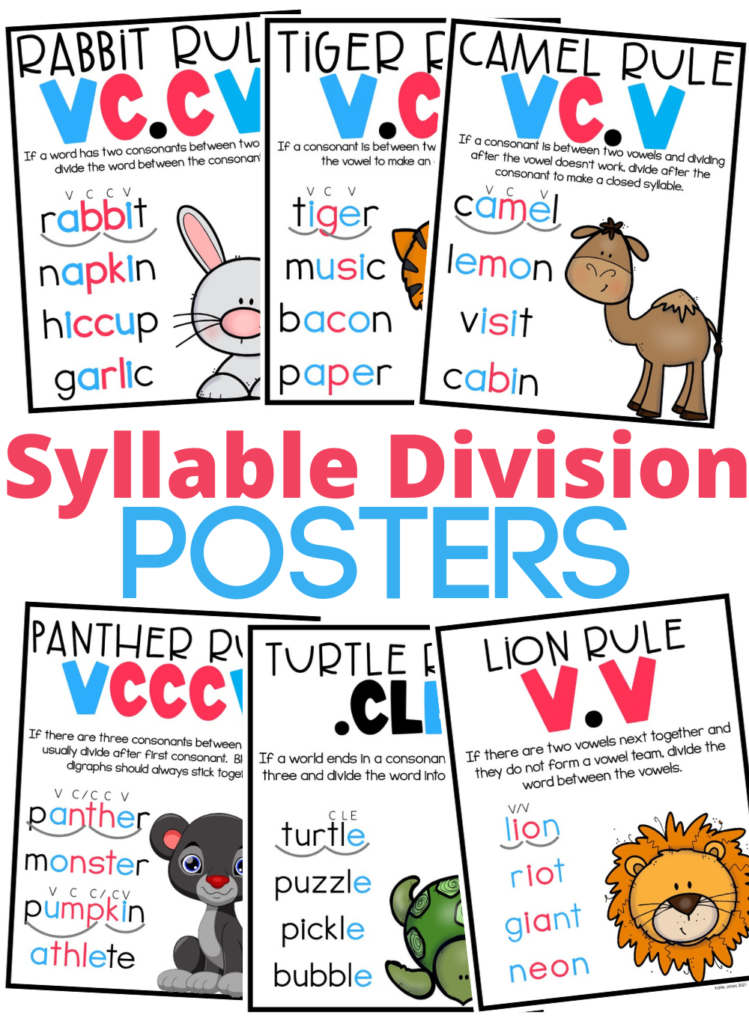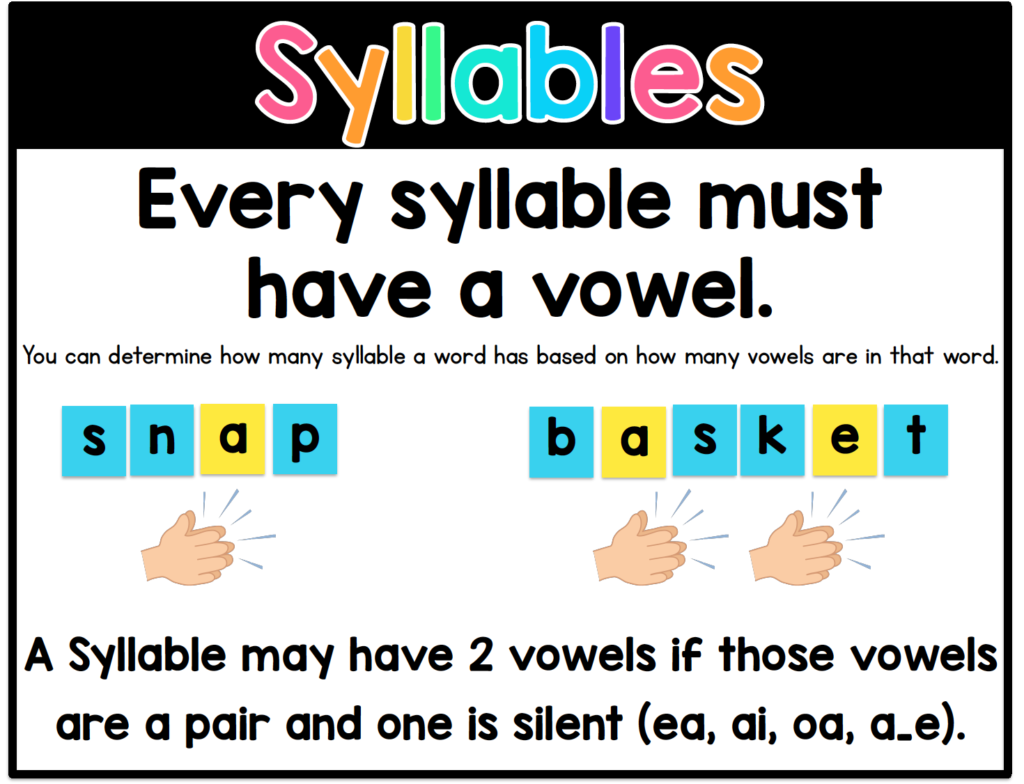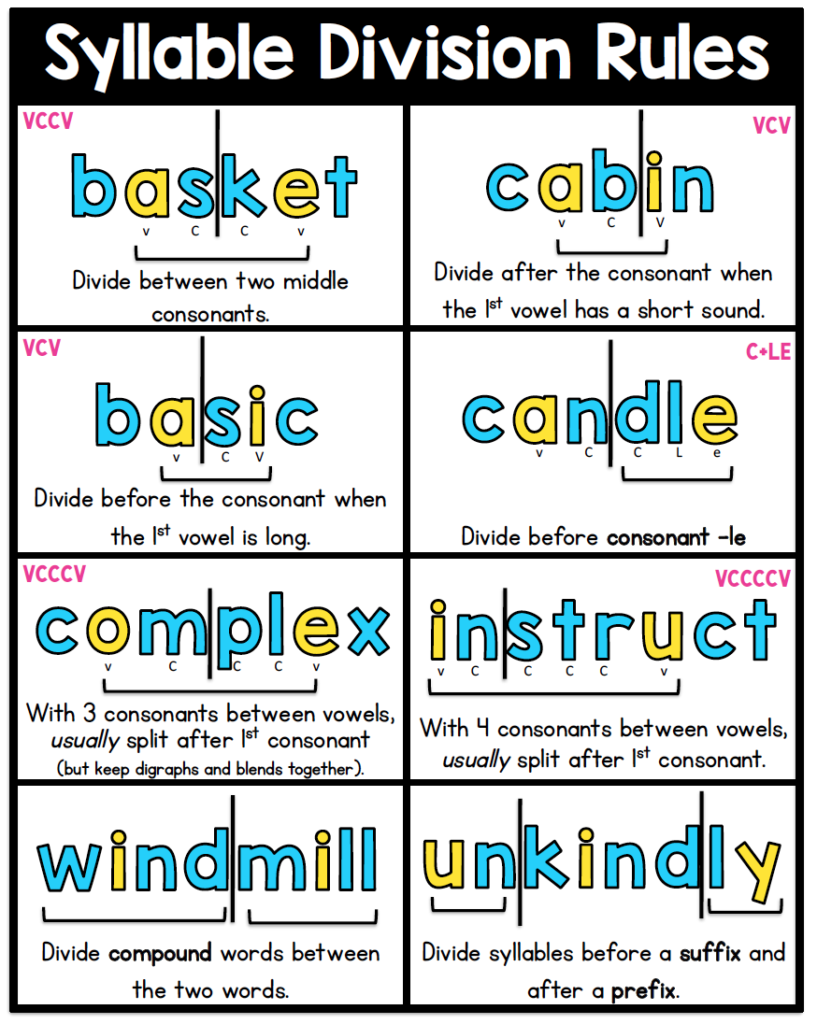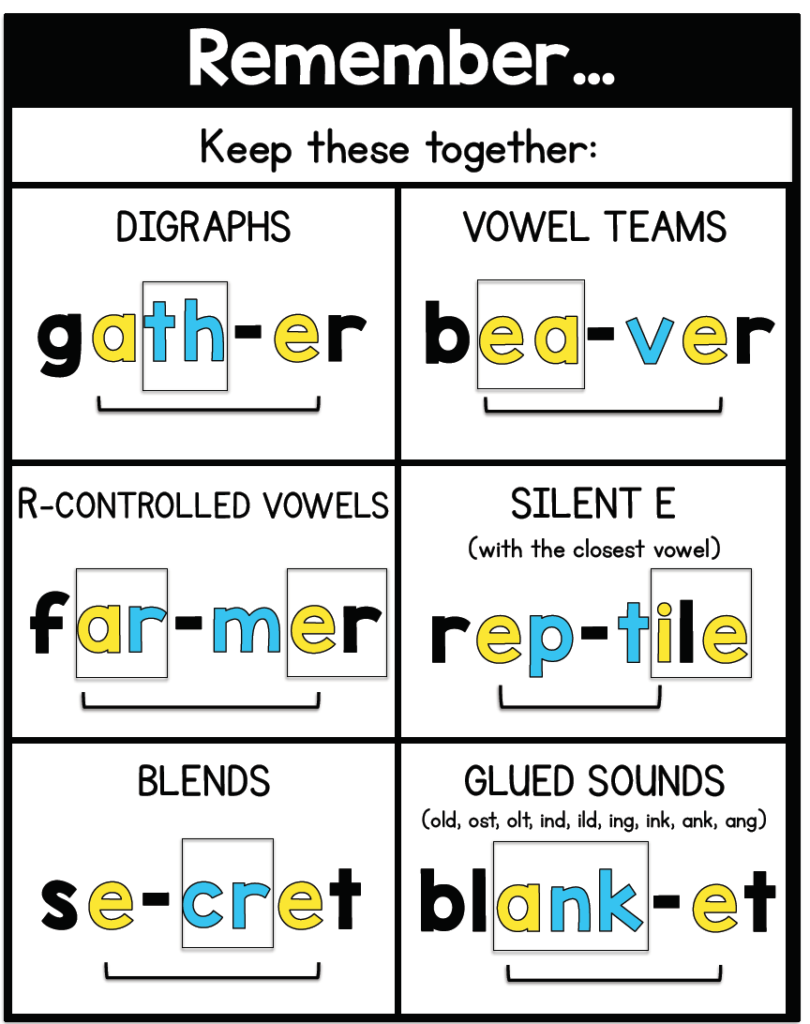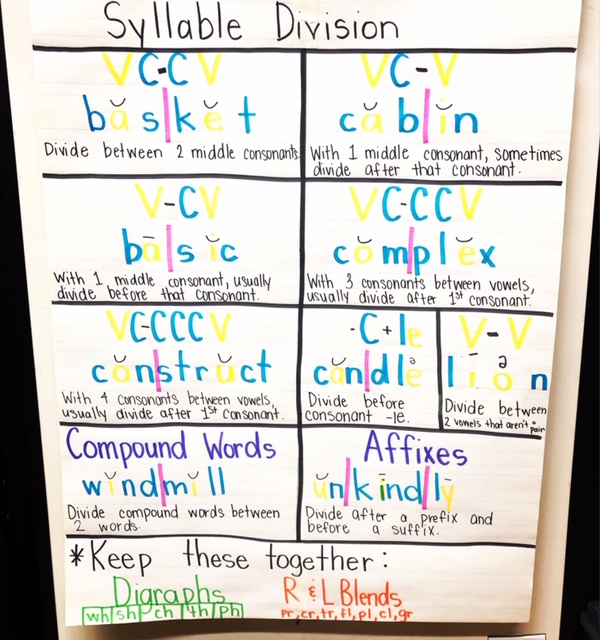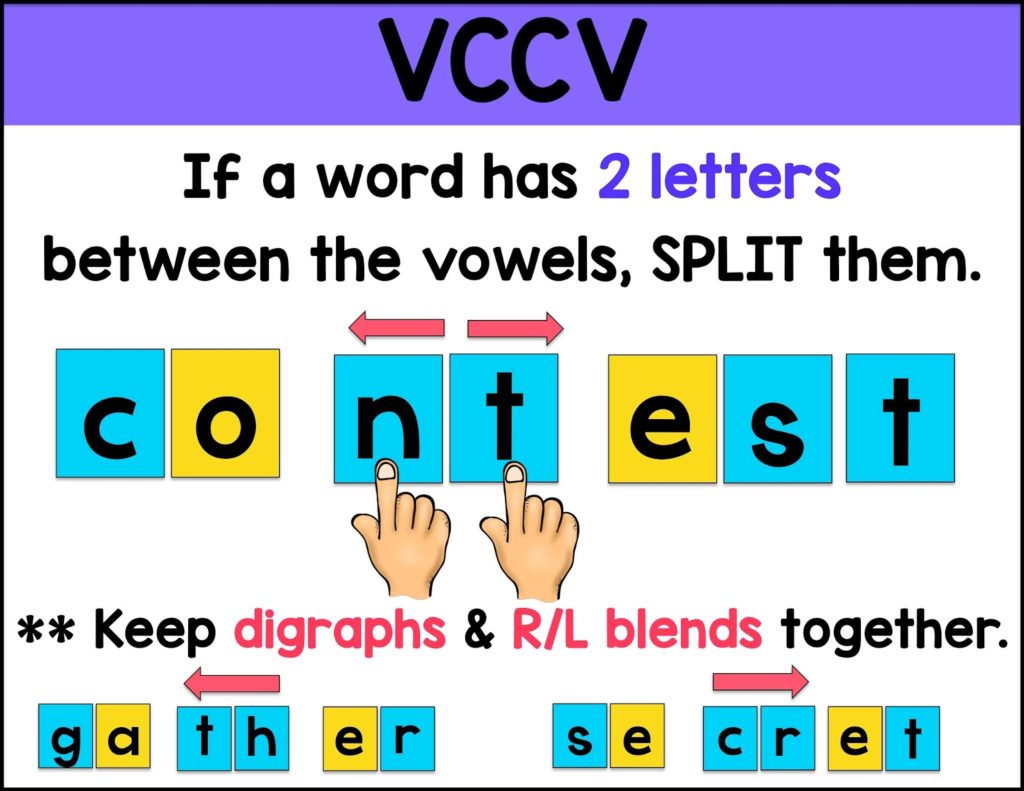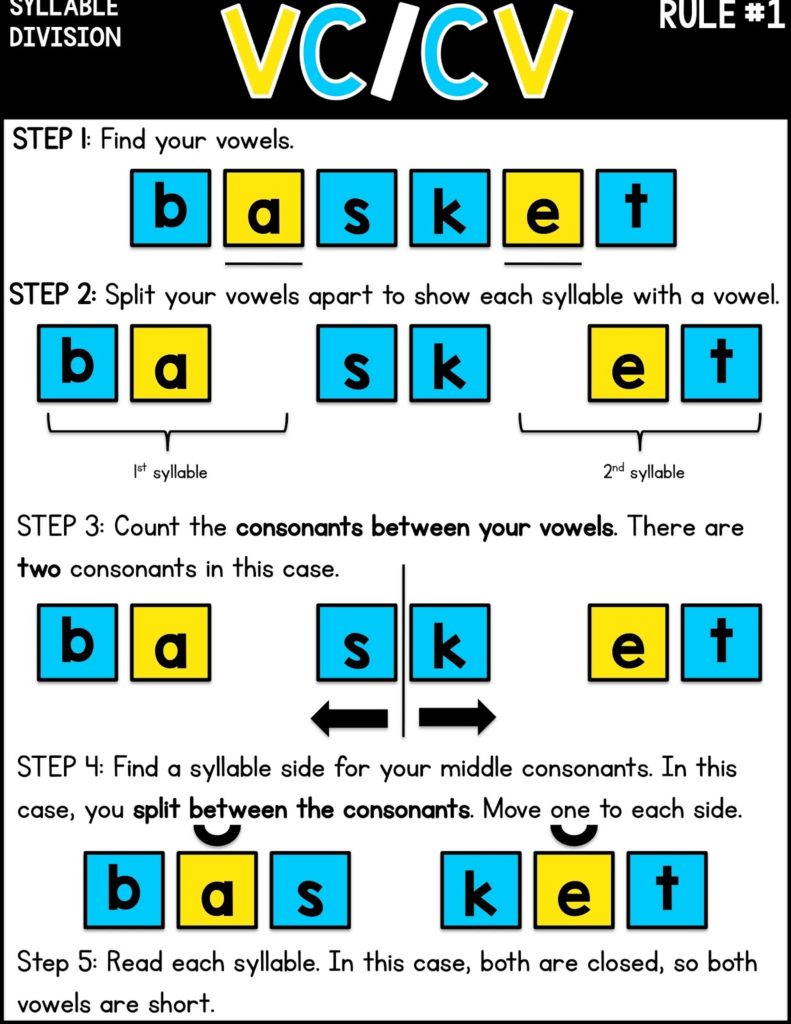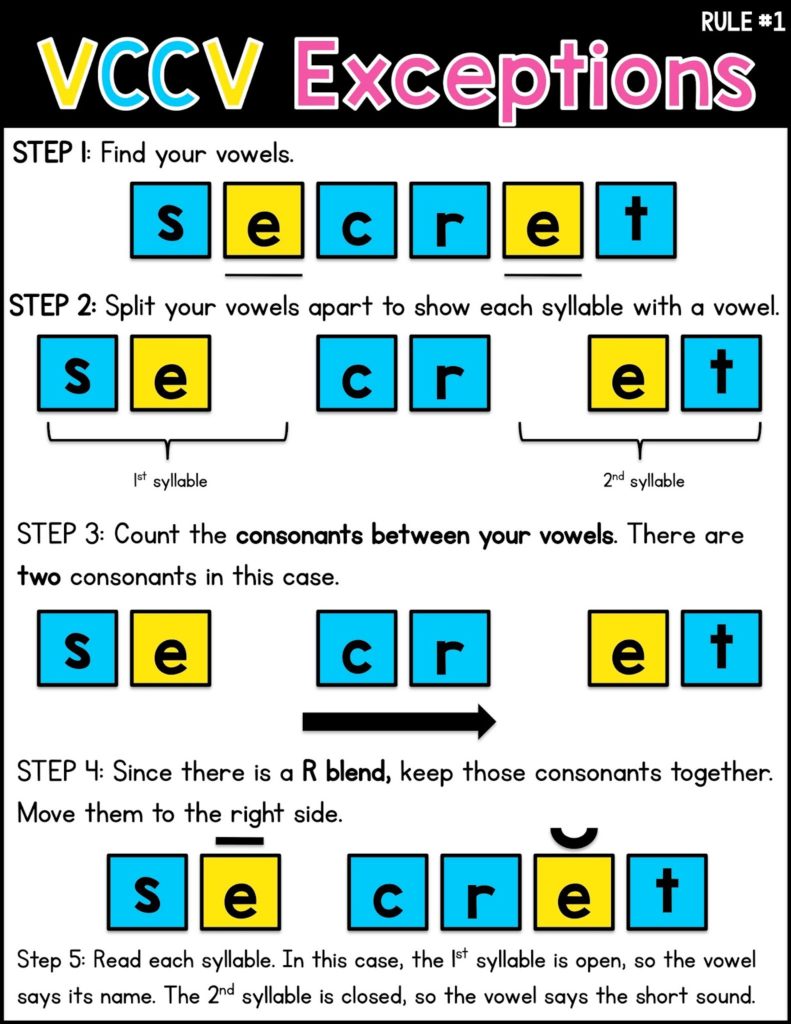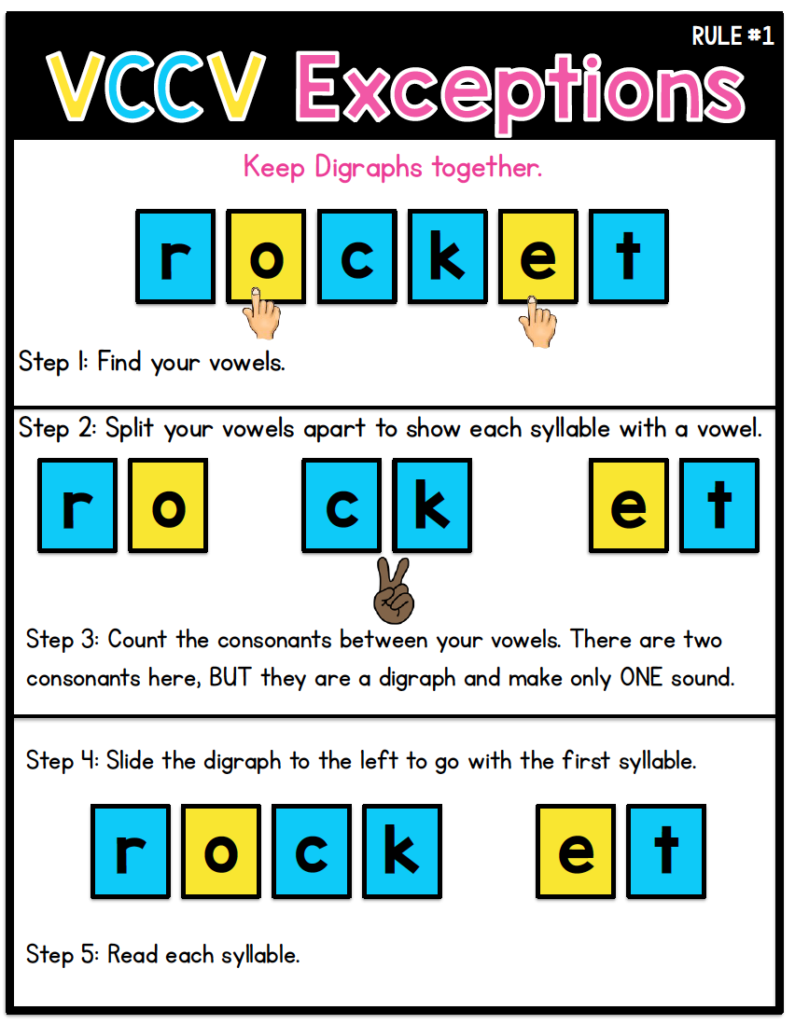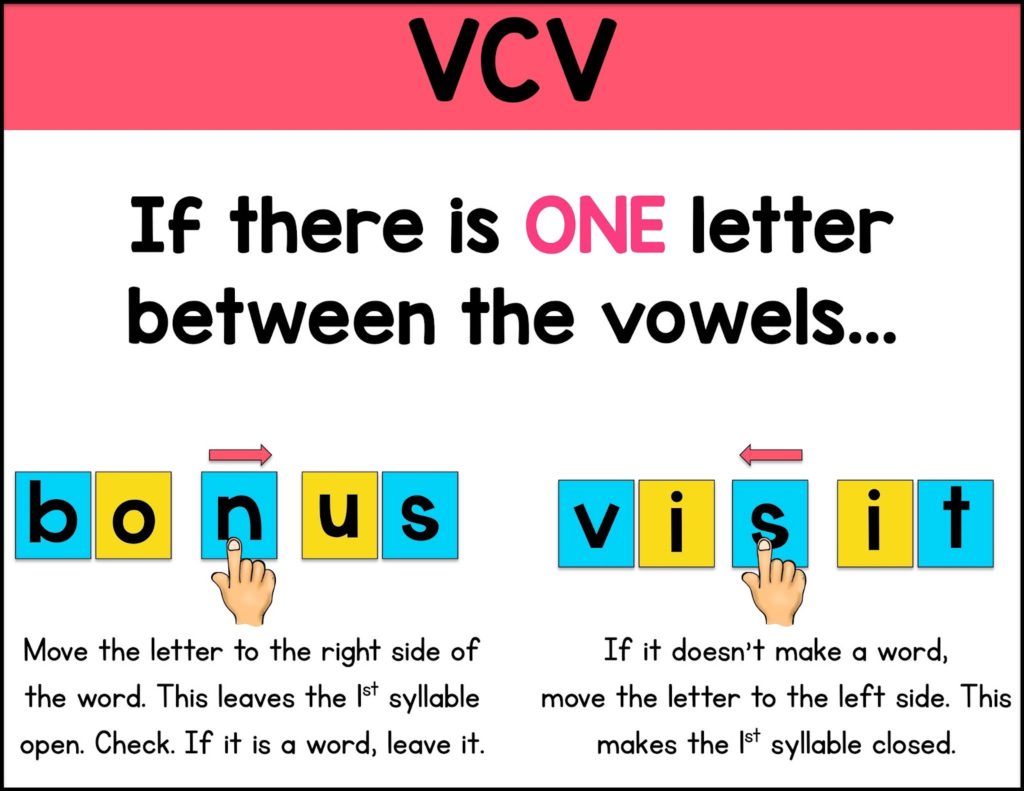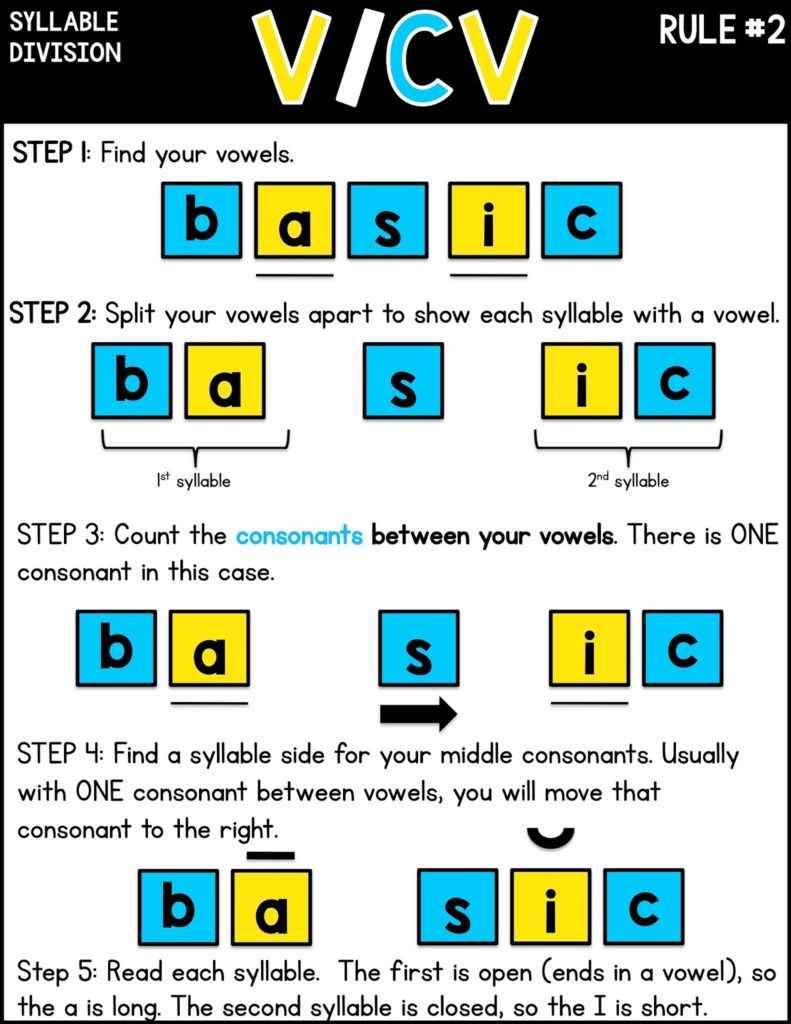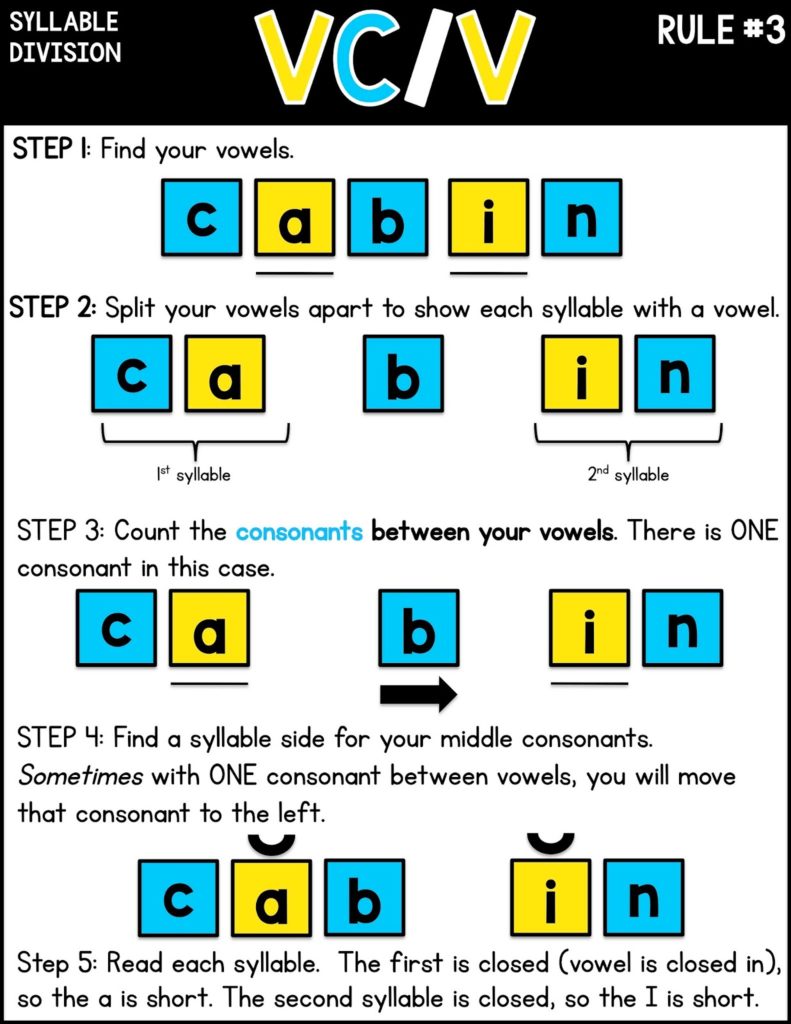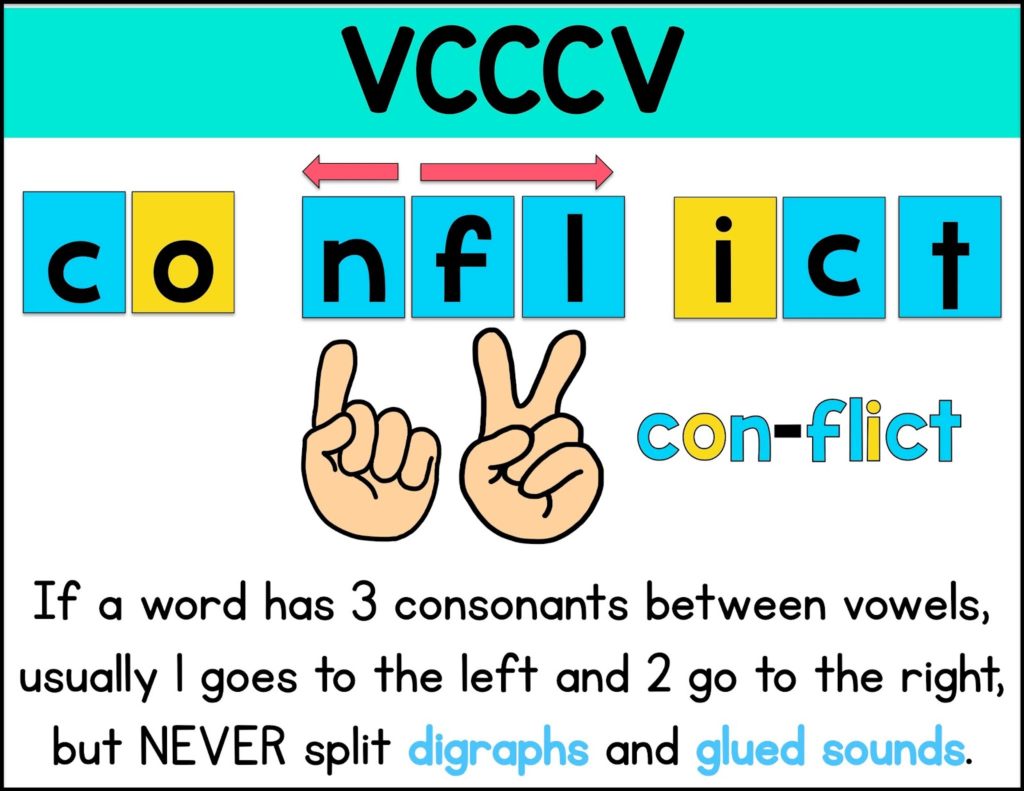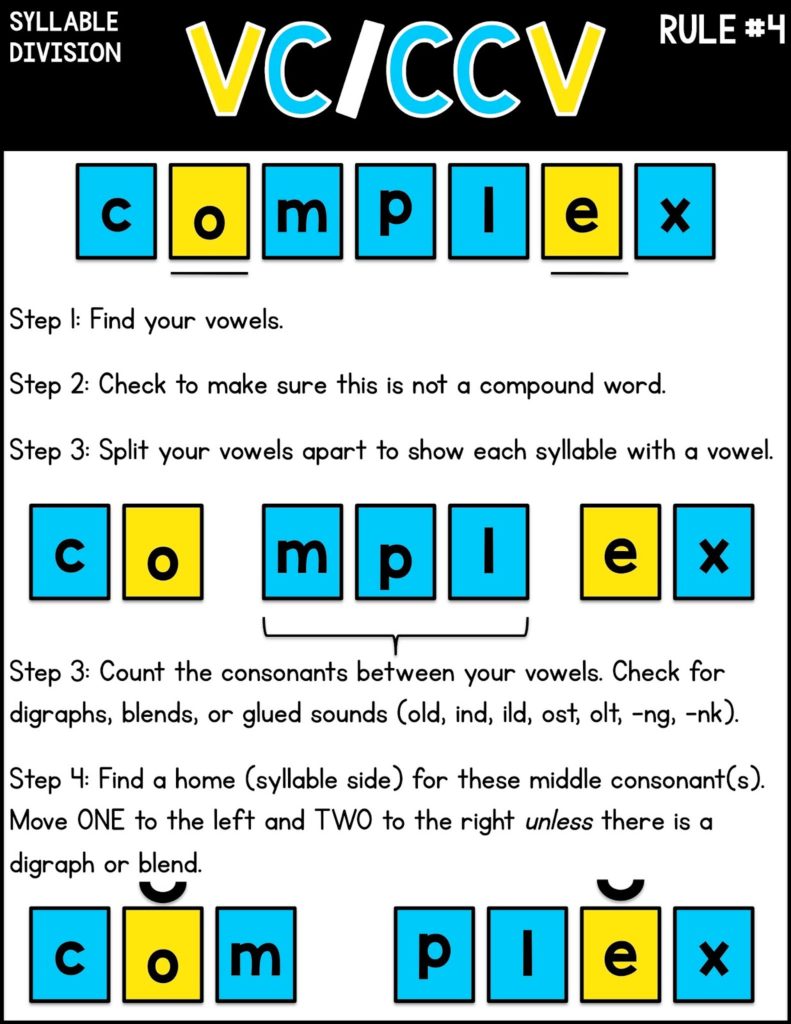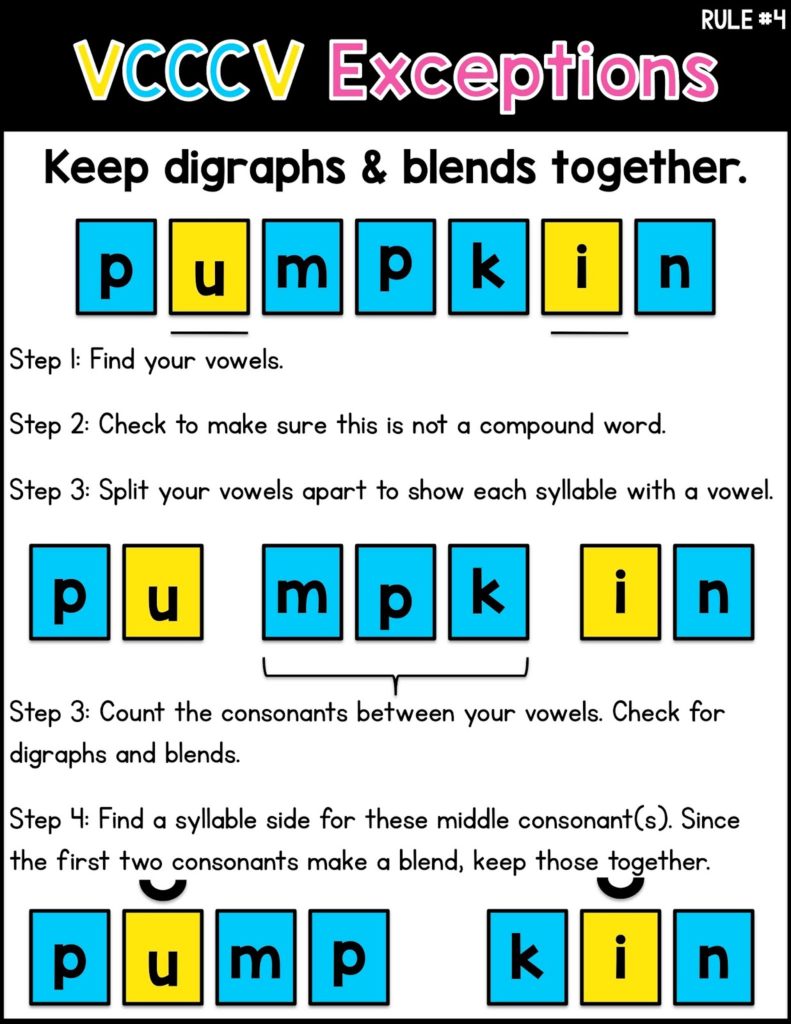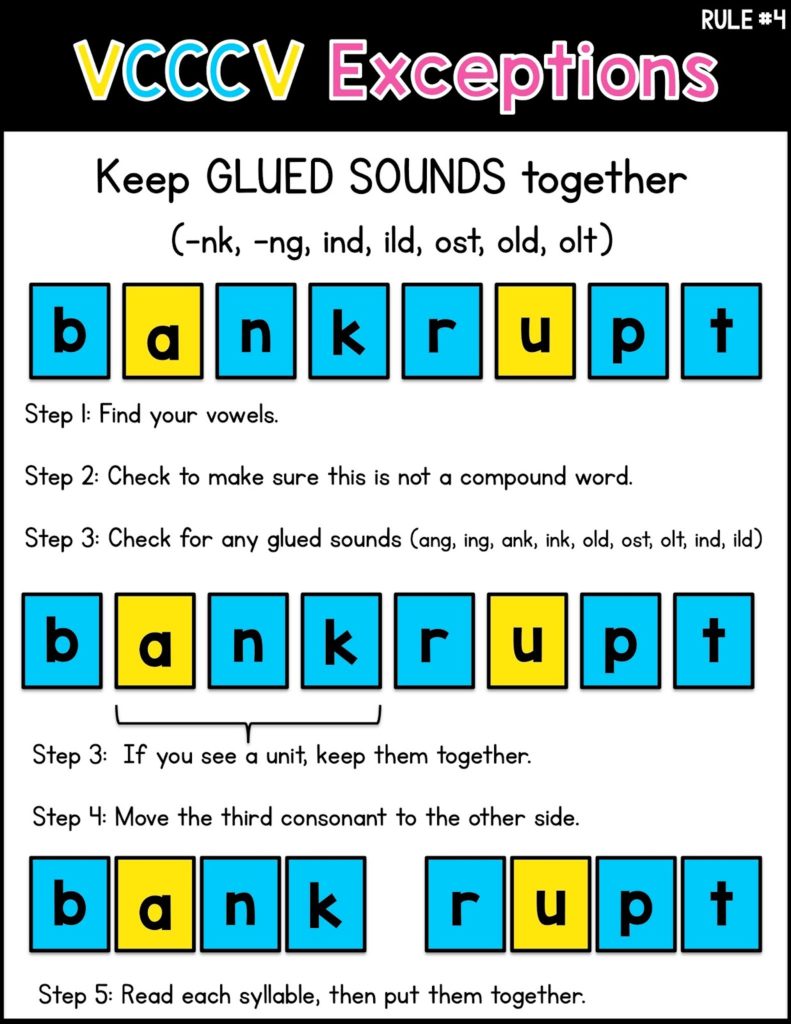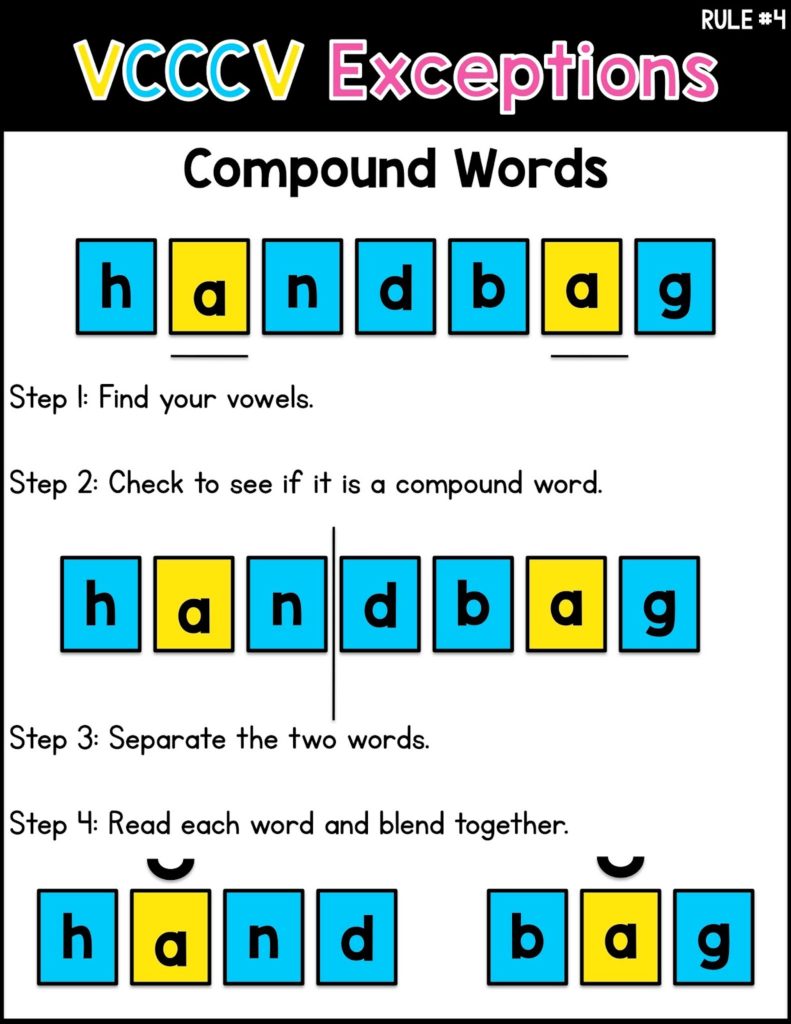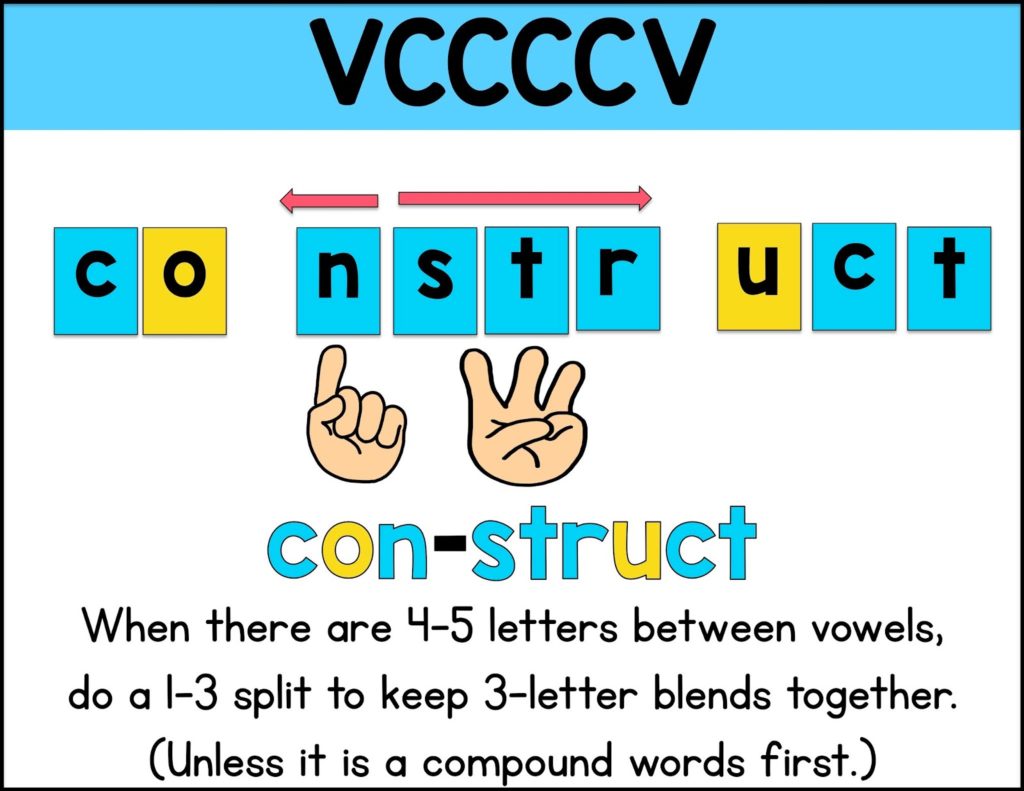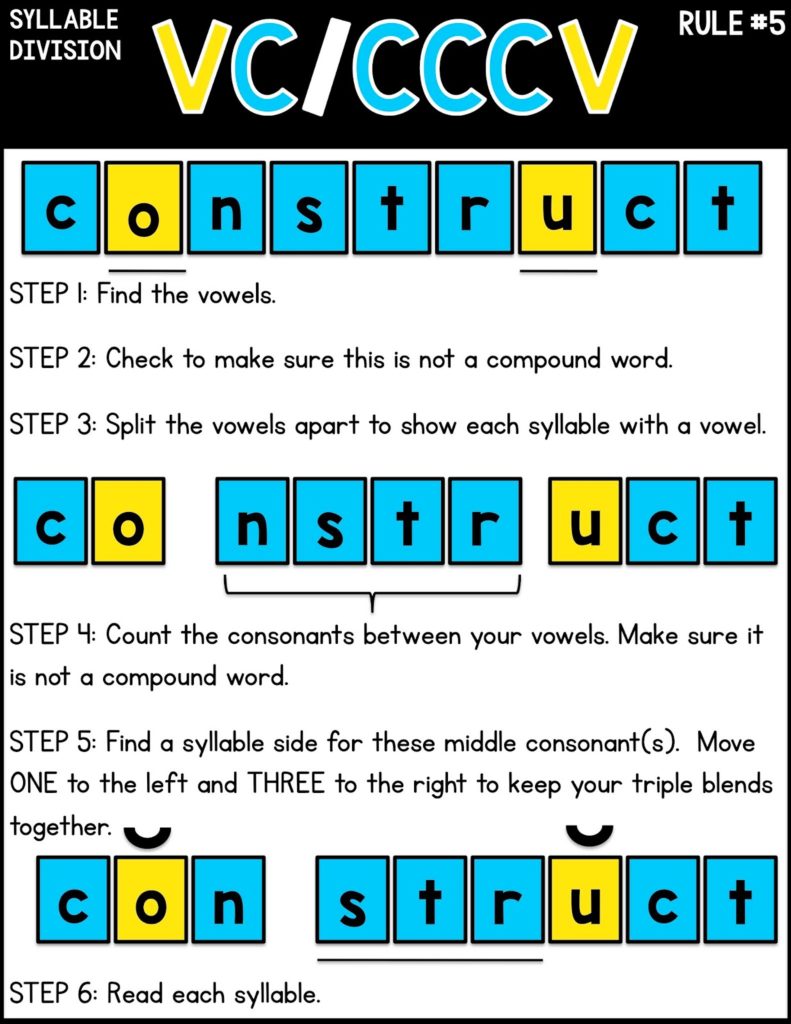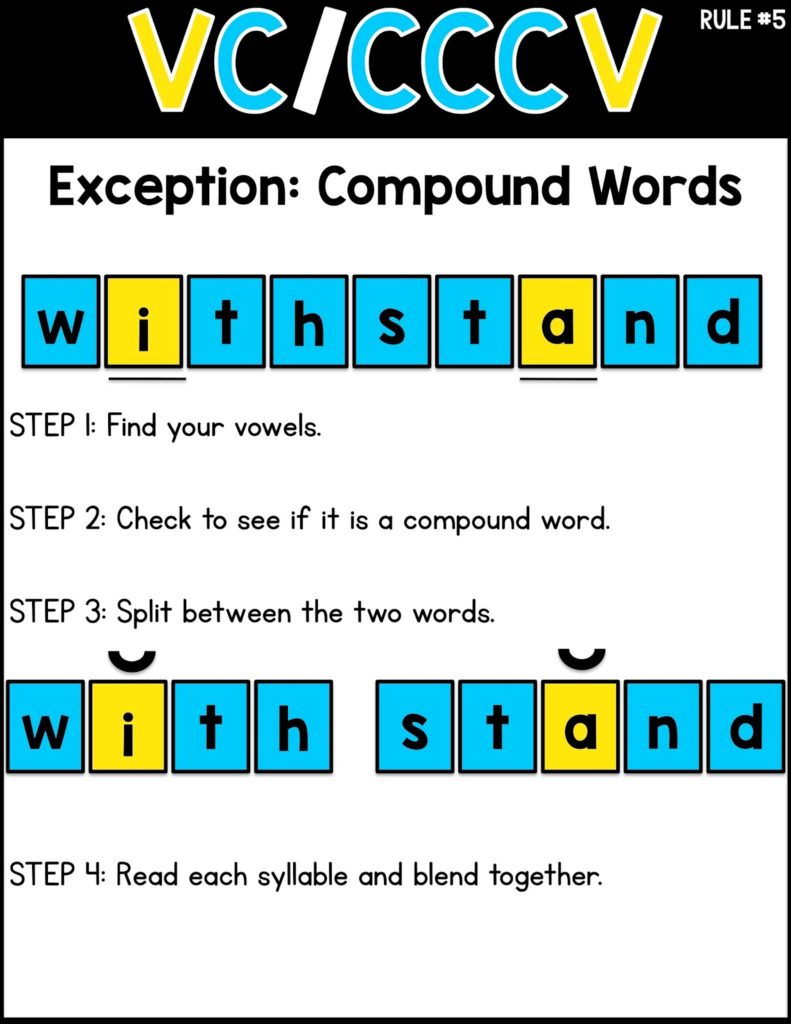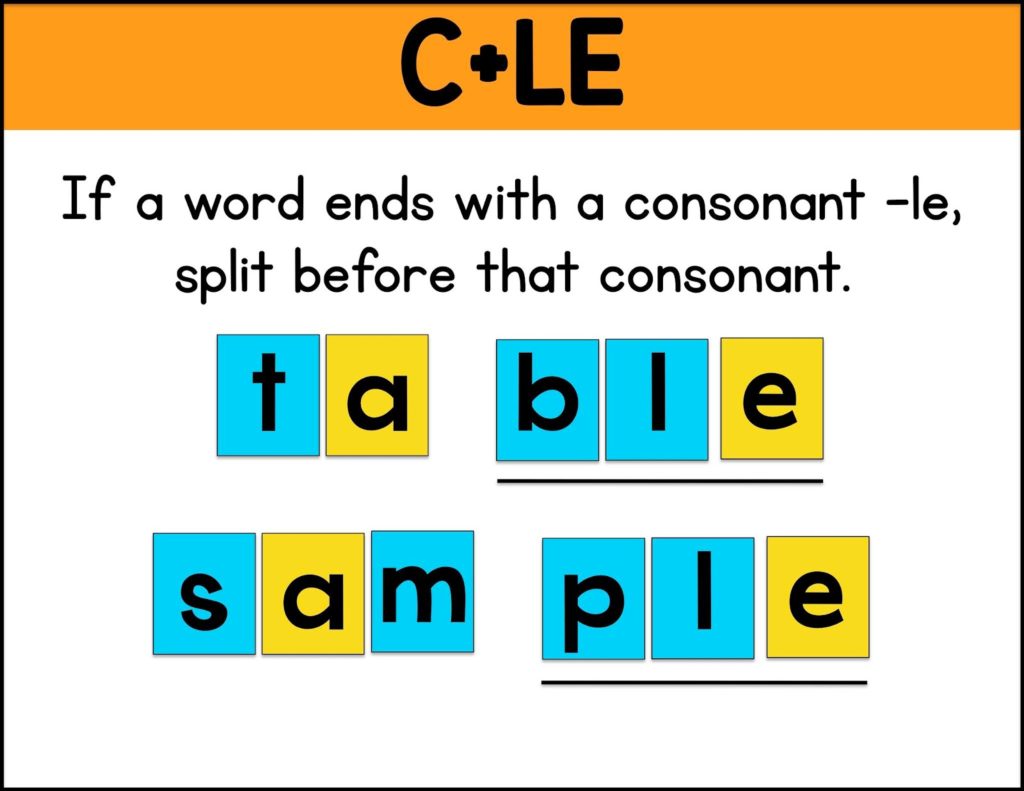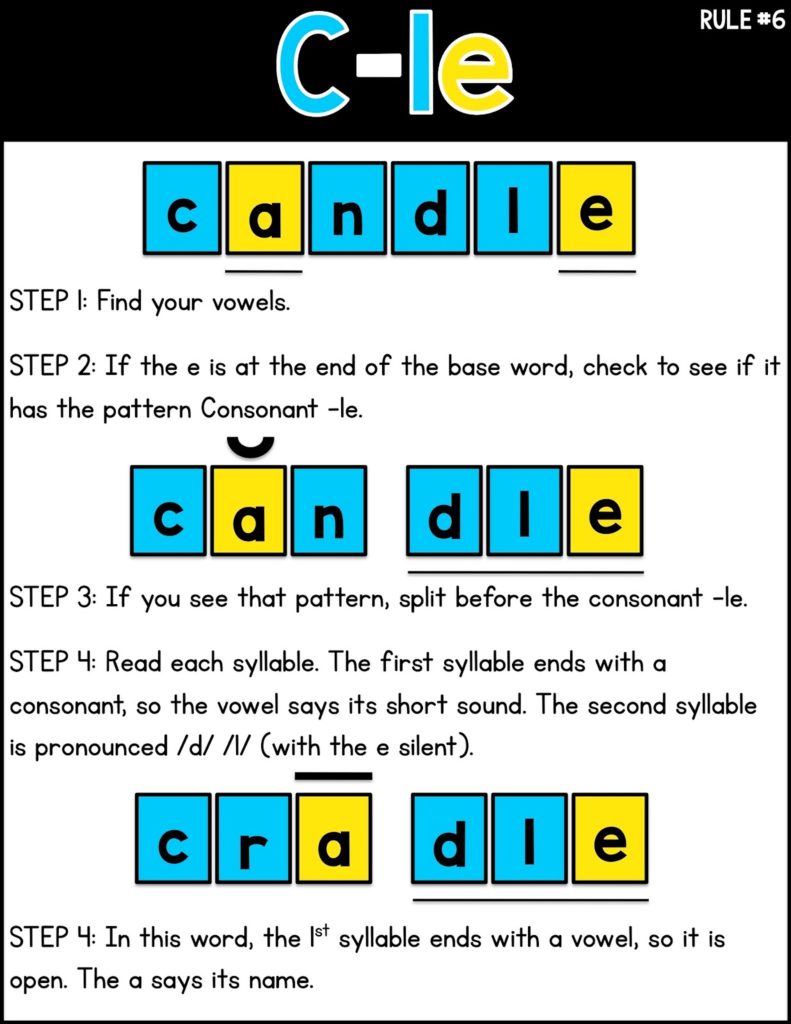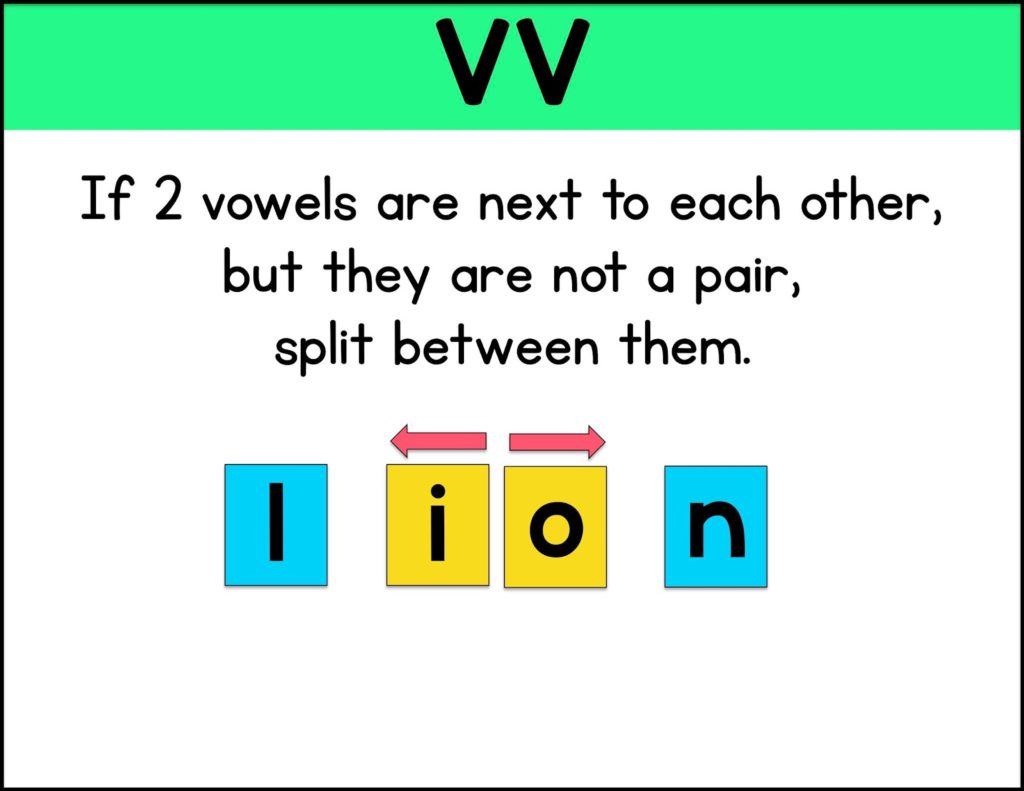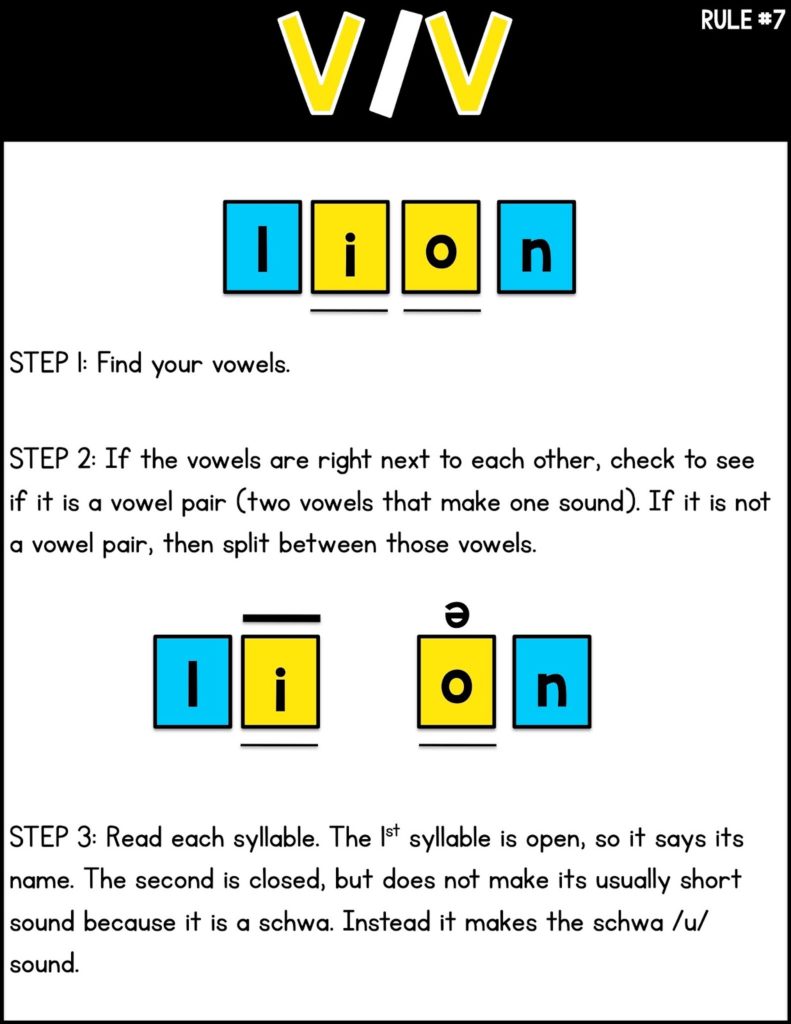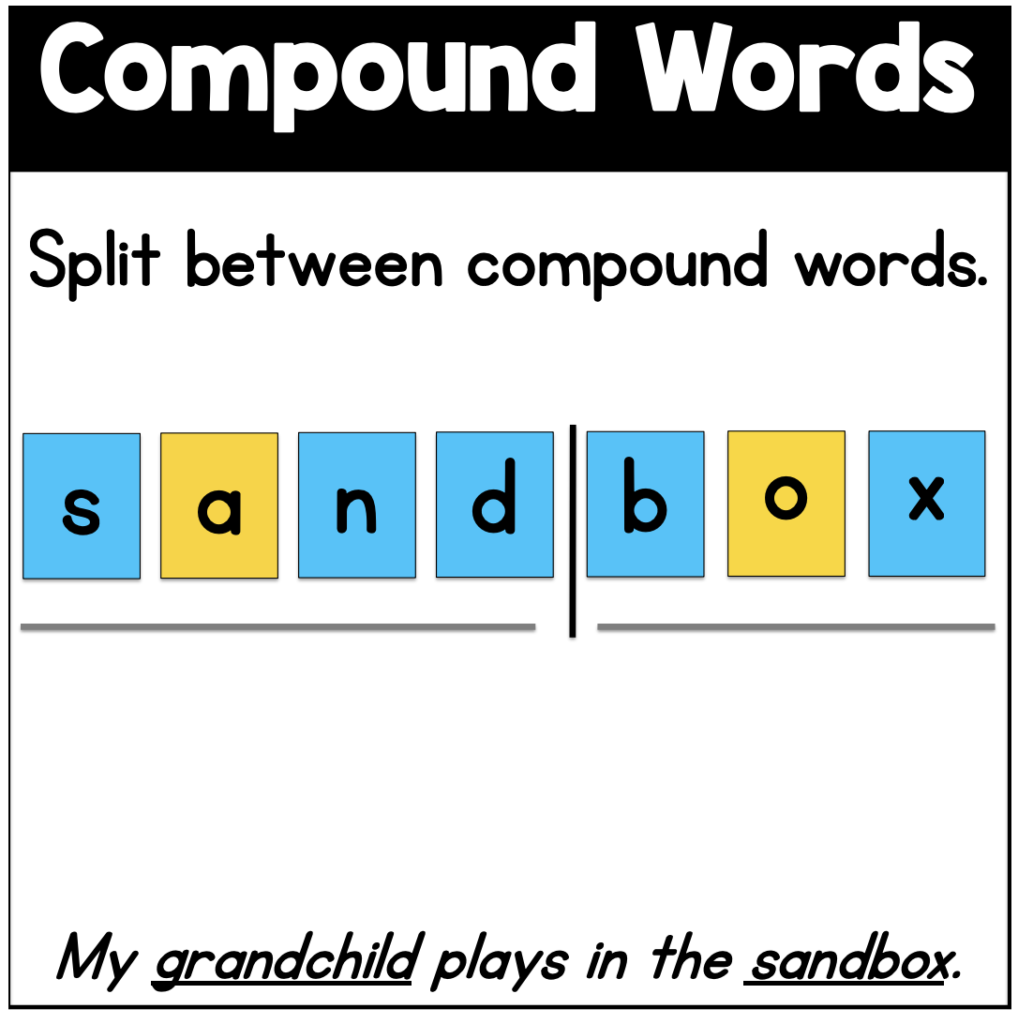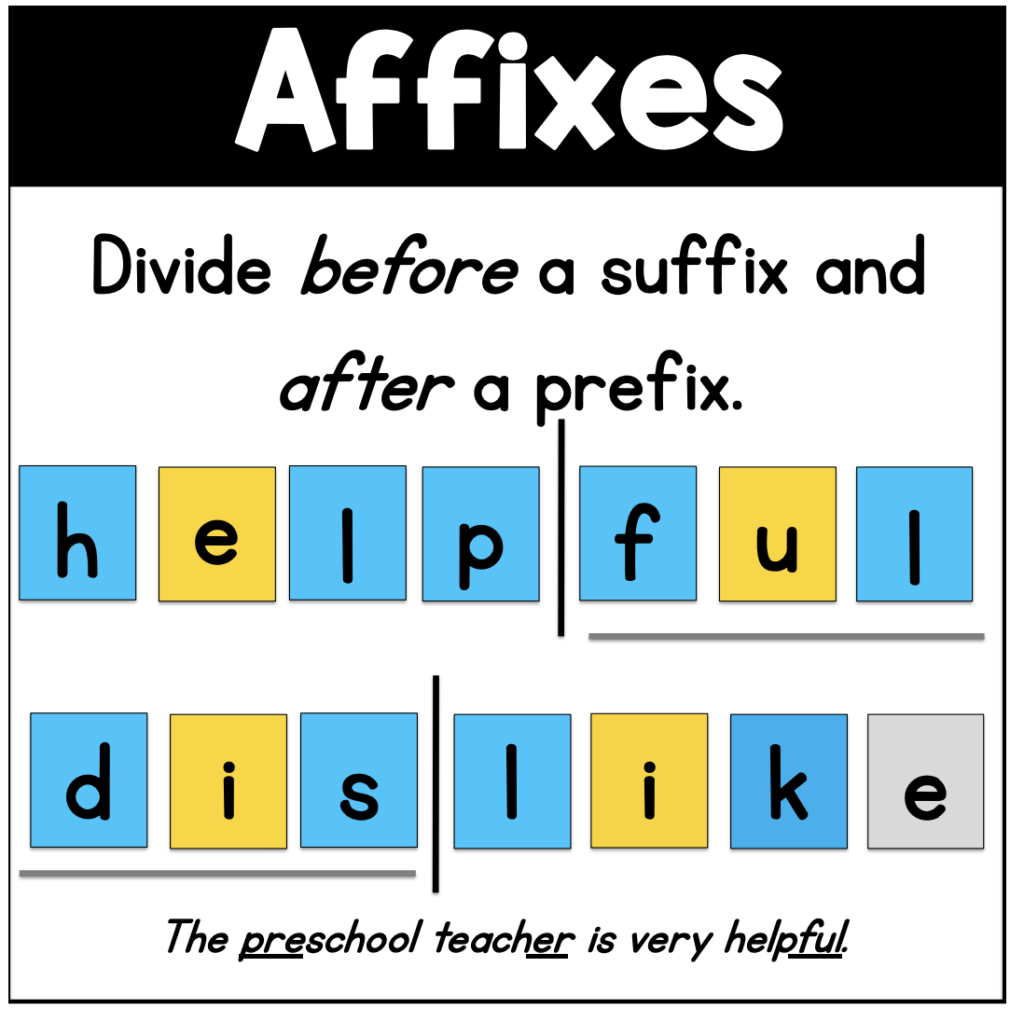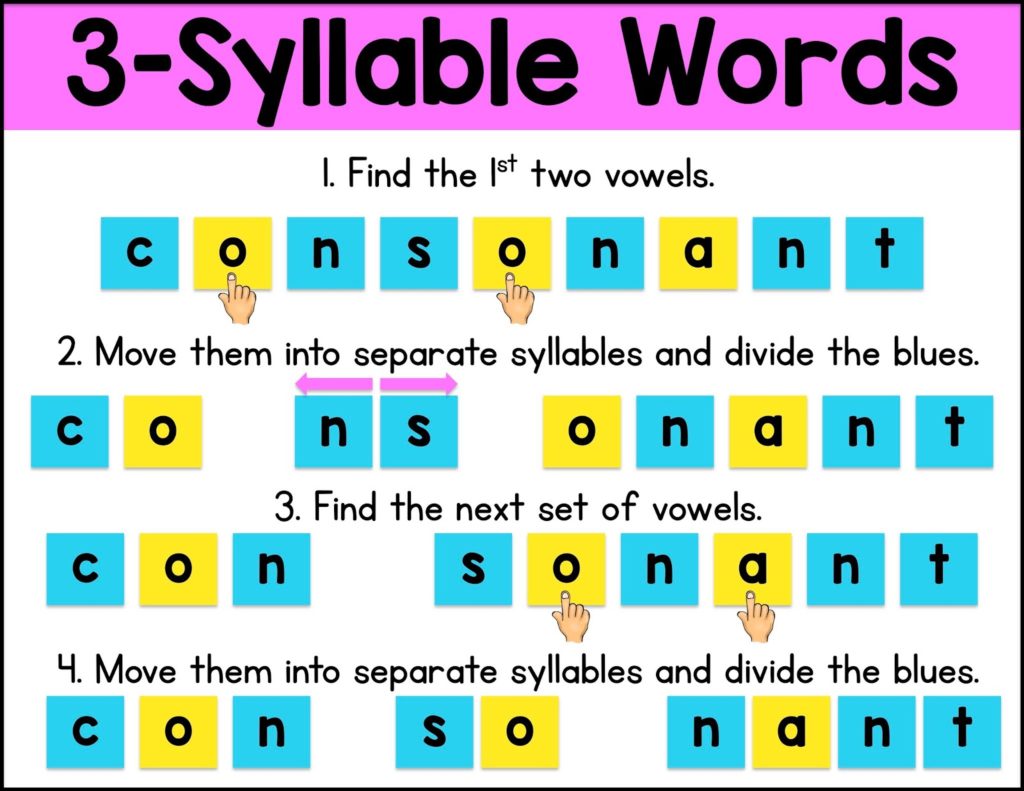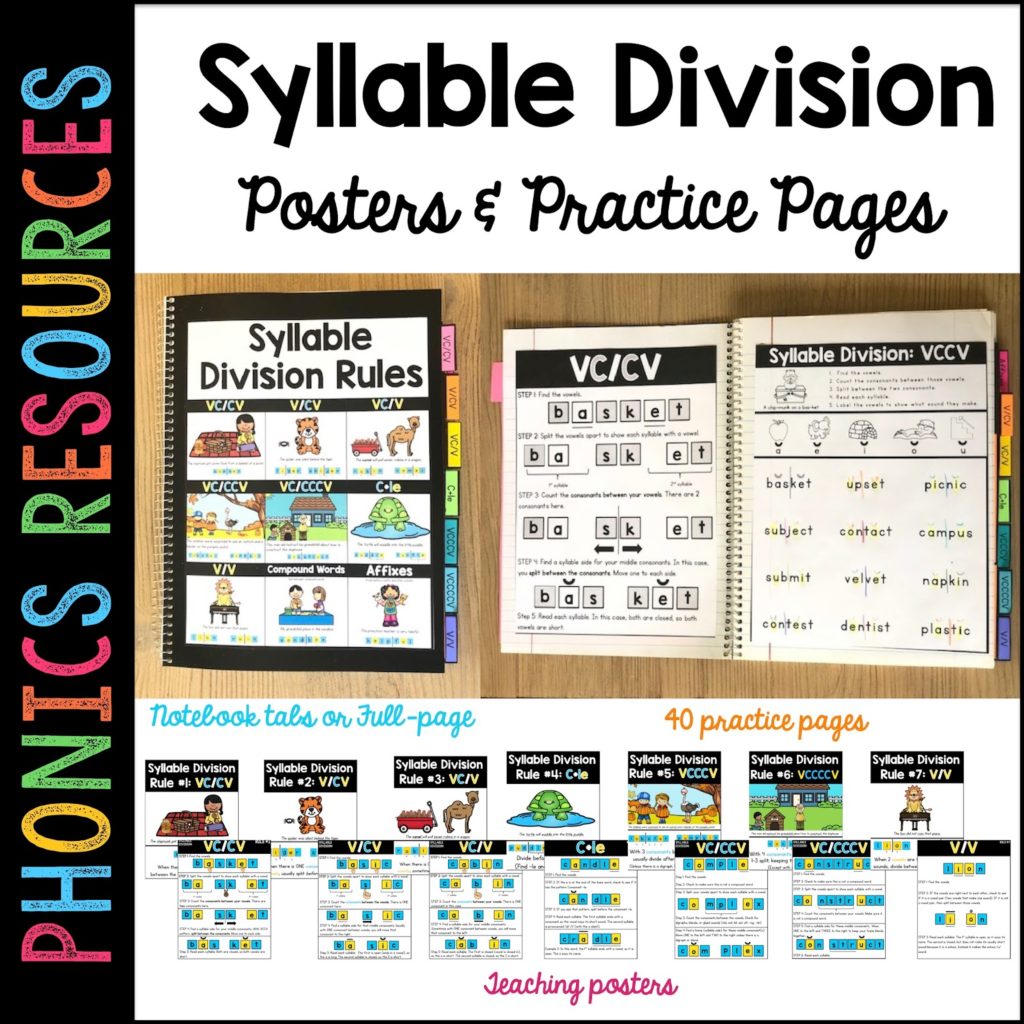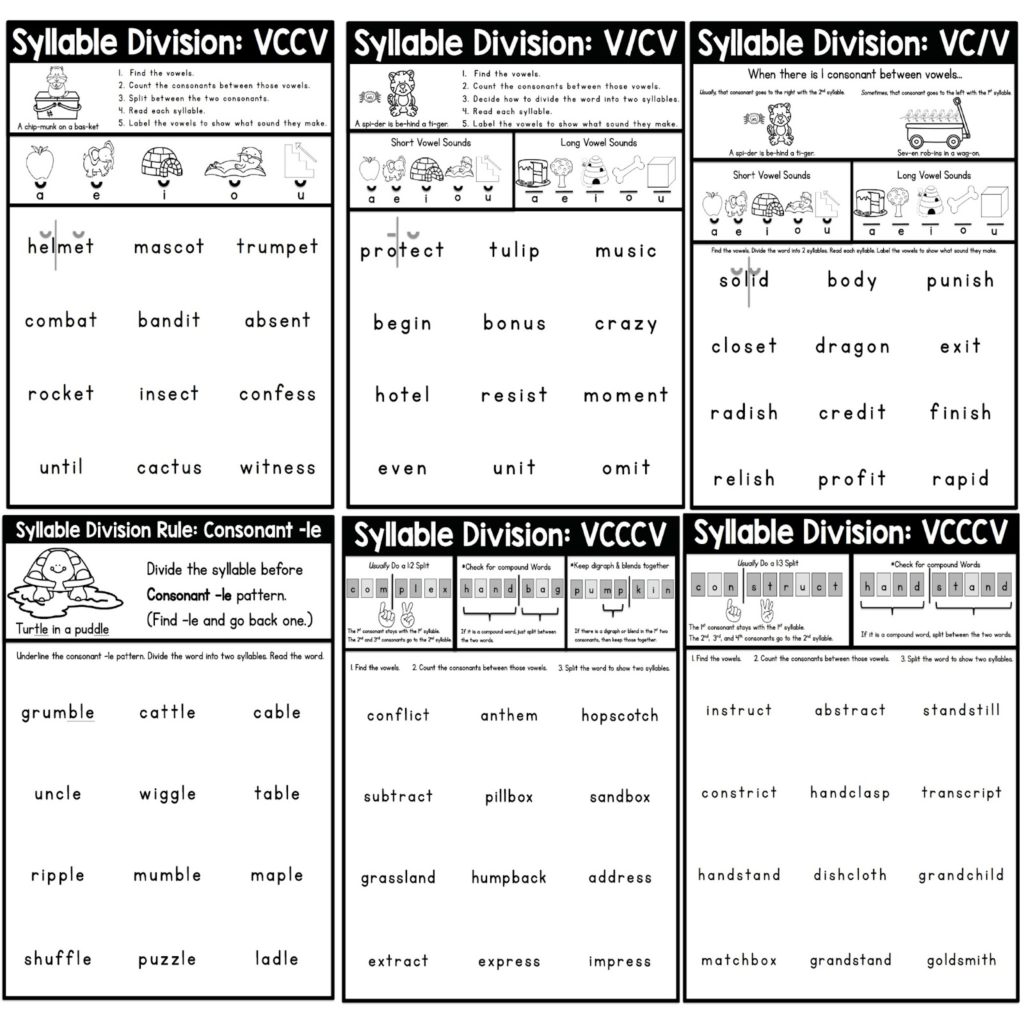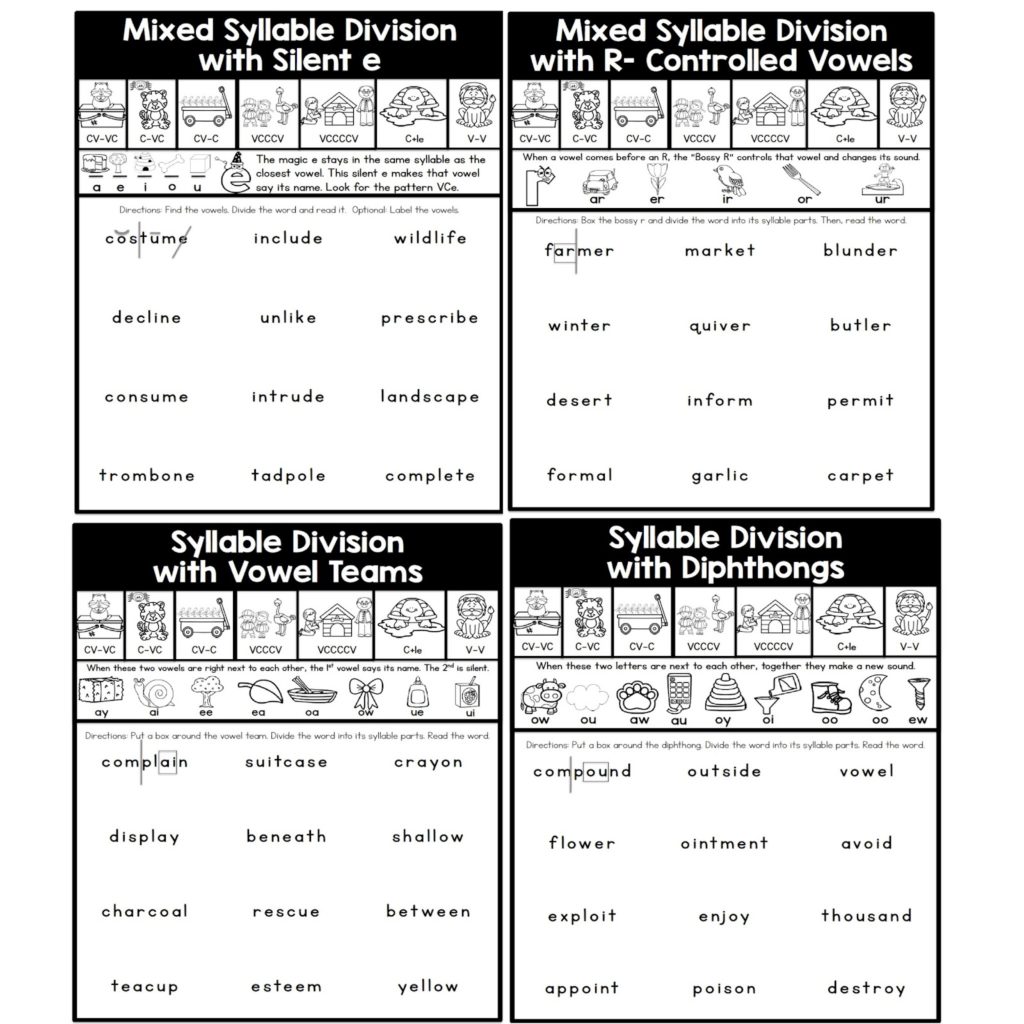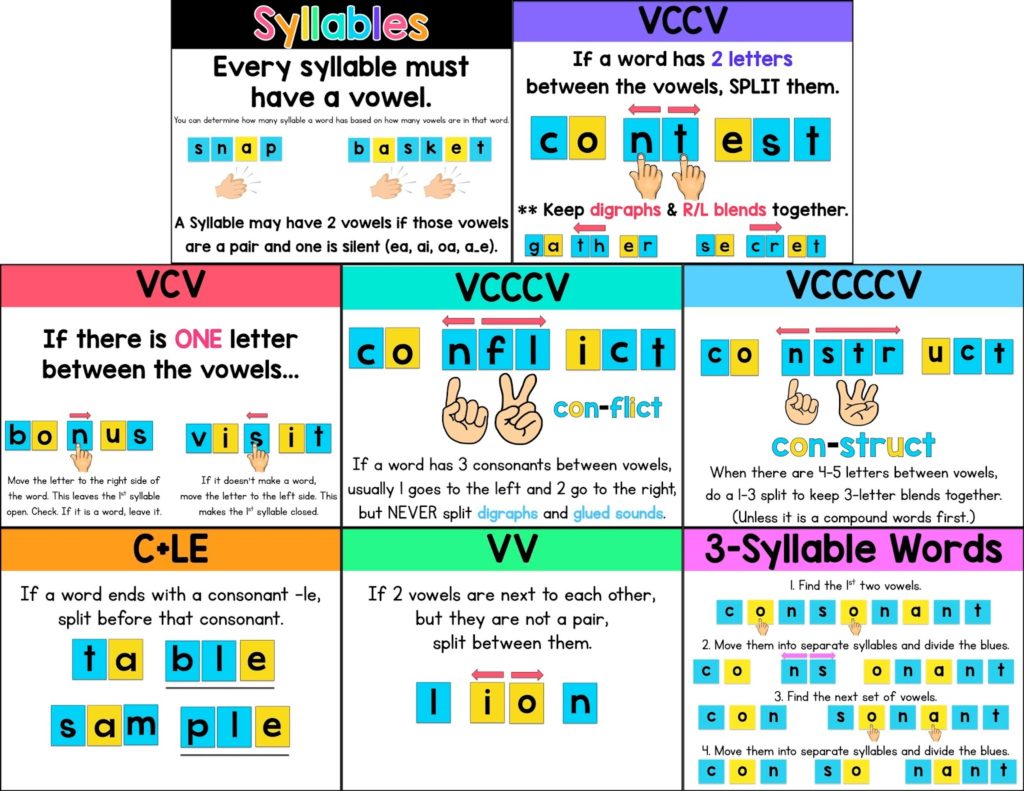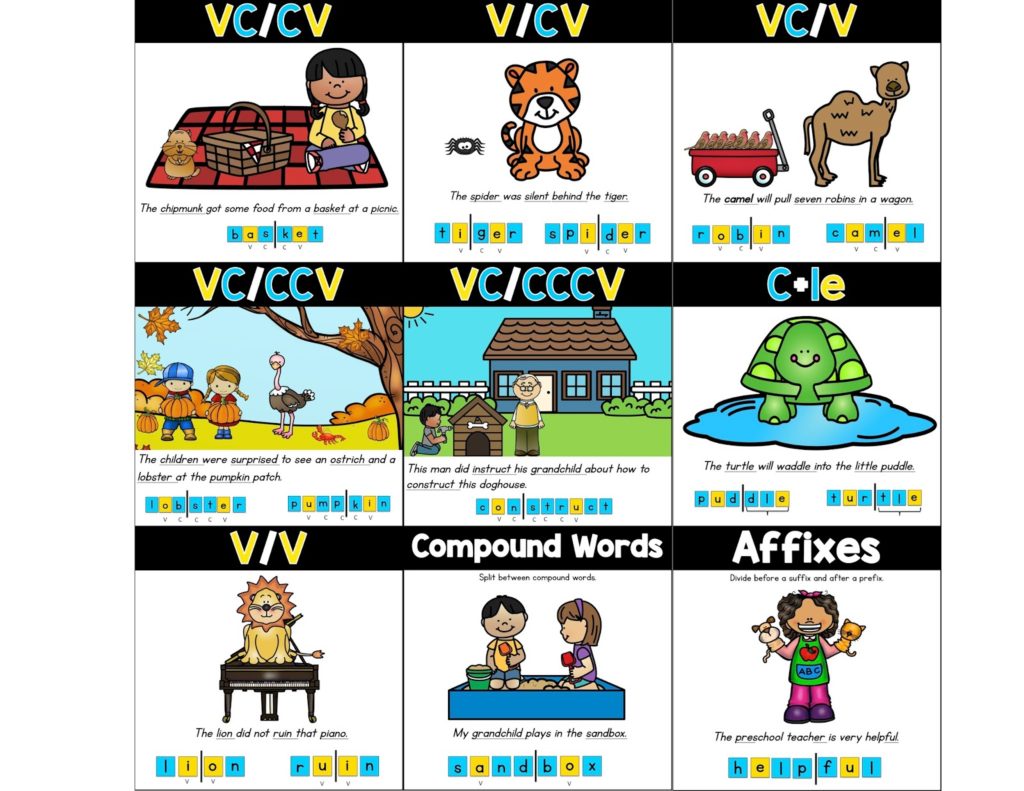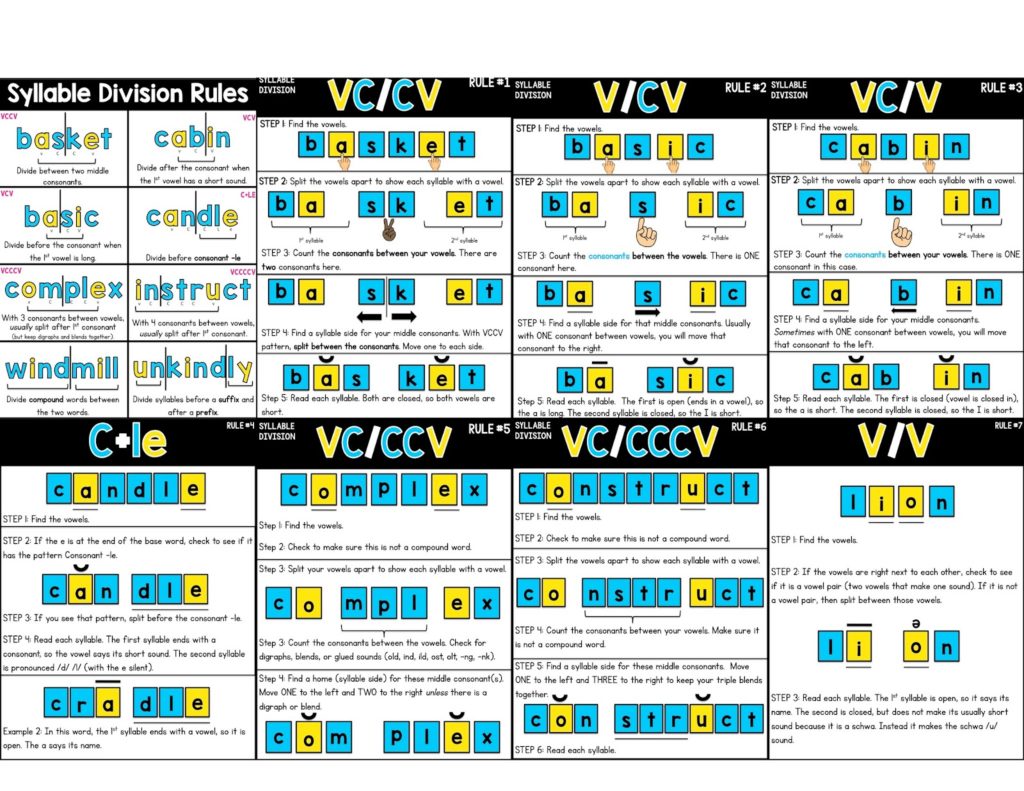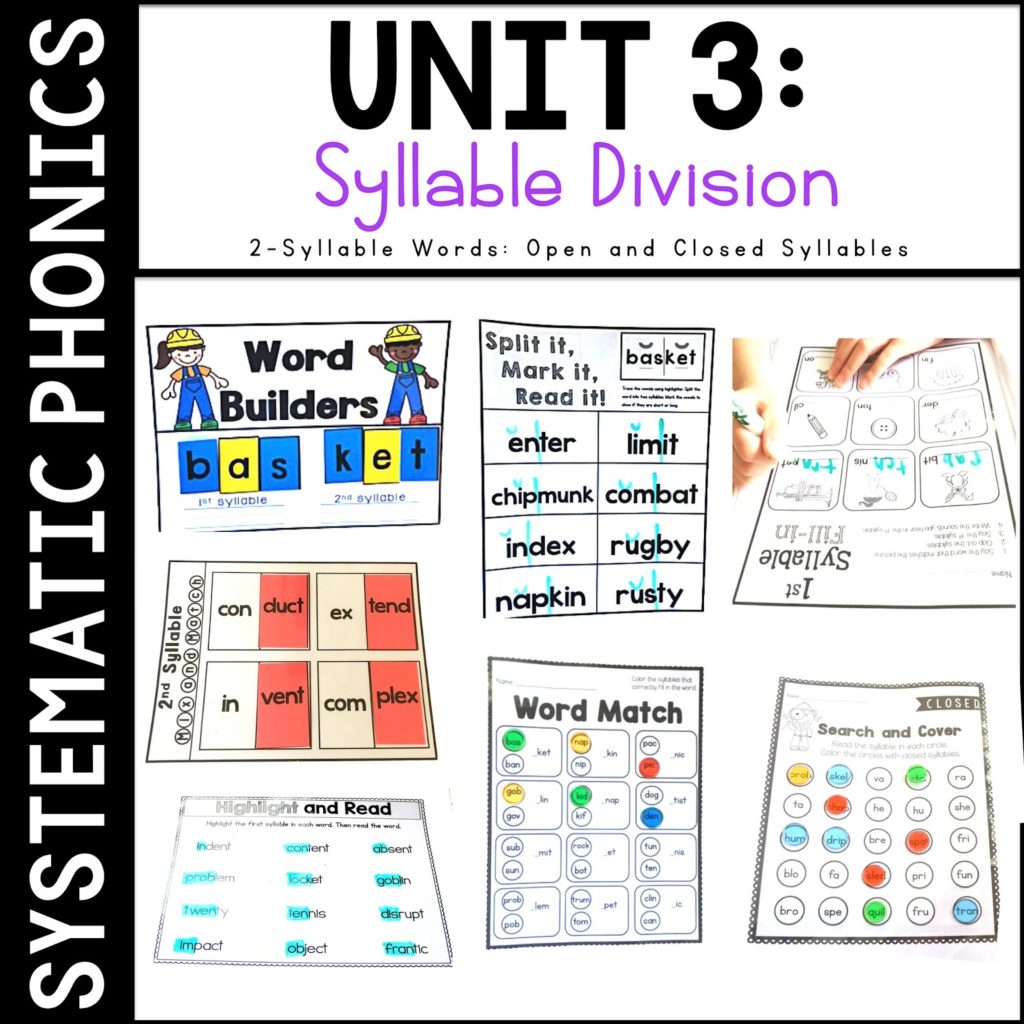Syllable division rules show us how to break up a multi-syllable word into its syllable parts. There are six main syllable division “rules” to guide us.
How is Syllable Division done?
- It all starts with the vowels. Find the vowels in the word. It helps to underline or highlight them.
- Find the patten of the consonants and vowels (VCV, VCCV, VCCCV, VCCCCV, C+le, VV).
- Use the syllable division rule (shown below) to divide the word into its syllable parts.
Why Should we Teach Syllable Division?
Learning the rules of syllable division provides our students with an effective strategy for chunking up those bigger words into more manageable parts. I see it as another “tool” for their “tool belt” that leads to more accuracy while reading.
Understanding syllable division also helps students to determine what the vowel sound will be. As I learn more, I see this works best when incorporated with morphology (think prefixes, suffixes, and roots). When I first learned syllable division, I only learned syllable division without the consideration of morphemes (which are the smallest units of meaning in our language). I now teach my students to look for familiar prefixes, suffixes, and even roots (for older kids) first. If there aren’t any, then begin syllable division.
To get to that point though, we need to teach them those syllable division rules and give them enough practice with them so that it becomes more automatic. All the while, I’m teaching new prefixes and suffixes to them so those can also become more familiar. I think the two actually go together well. But I digress! Back to syllable division!
The first thing to know is that every syllable must have a written vowel. The very definition of a syllable is an uninterrupted unit of speech with one vowel sound.
Here are the syllable division rules on one page:
Here is a picture from my classroom:
As I mentioned above, first thing to know about syllable division is that it’s all about vowels!
Every syllable needs a vowel, so we can determine (usually) how many syllables there are based on the number of vowels.
- Vowel teams and diphthongs count as one syllable even if there are two vowels because they work together to make one sound.
- Same with silent e. The e doesn’t make a sound so it doesn’t get it’s own syllable.
- The exception of course is the syllable type consonant -le. This syllable is found in words like little, bubble, table. You cannot hear the e, but it does get its own syllable. It buddies with the l before it and the consonant before the l. More about that later, though!
Syllable Division Rules
The following slides show the main syllable division rules.
Rule #1: Two consonants between the vowels: VCCV Pattern
The first syllable division rule is VC/VC, which stands for vowel-consonant-consonant-vowel. Train your students to find the vowels in the word. They are our starting point. In words with the VCCV pattern, there are two consonants between the two vowels. Usually, we split between those consonants.
See the step by step directions with blue and yellow letters below. (Before teaching this, you should teach your students about open and closed syllable types. For the word basket, split between the s and k. The first syllable is bas and the second syllable is ket. Each syllable has a vowel.
Of course there are always exceptions.
- One exception is when there are R or L blends, like in the word secret. We keep R and L blends together, so instead of splitting between those consonants, we keep them together and move them to the second syllable.
- We also keep digraphs and units (ing, ink, ang, ank, ost, olt, ind, ild, olt) together. Never split those!
Rule #2 & 3: One Consonant between the Vowels: VCV Pattern
There are two options here! This slide shows both ways.
More commonly, you would split VCV syllables the before that consonant. This leaves your first syllable open, so the vowel would be long.
- In the word silent, the letter l is the middle consonant between the vowels. We move that to be with the 2nd syllable: si-lent.
- In the word bonus, the letter n is the middle consonant between the vowels. We move that to be with the second syllable, leaving the first syllable open (because it ends with a vowel) bo-nus
Sometimes though, we do the opposite. Sometimes, we split VCV syllables after the consonant. In this case, we close that first syllable, leaving that vowel short.
- In the word robin, the middle consonant b moves with the 1st syllable making rob-in. The first syllable rob is closed by the b.
- In the word visit, the middle consonant s moves with the 1st syllable making vis-it. The first syllable vis is closed by the v.
Rule #4: Three consonants between the vowels.
In the case of three consonants between the vowels, we usually split after the first consonant.
- In the word conflict, the letter nfl are between the vowels. The first consonant n goes with the first syllable and the other two (fl) go to the 2nd syllable: con-flict.
See below that there are the usual exceptions.
- We never split digraphs, blends, or units.
- Also, a word this big can often be a compound word. Instead, you would split between the two words.
Rule #5: Four Consonants Between the Vowels
This is super similar to the last one. Split after the first consonant, unless it is a compound word. There are not as many of these words, and honestly when you’re getting into words this big, I tend to shift my focus to morphology.
Rule #6: Consonant -le
On paper, I’ve always had this as #6, but I actually found myself teaching this one after #3 because it came up earlier since it is so common. A great example is the word little.
Following this rule, we see the -le at the end and count one back to make lit-tle. Consonant +le in this word is t+le.
This is the syllable type where there is no vowel sound. You only hear the consonant and the /l/ or /ul/.
Rule #7: V/V
When there are two vowels next to each other, but they are not vowel teams or diphthongs (more than one letter making one sound together), then you split between the vowels. These two vowels do not share a sound. I think this is the hardest for my students to decode usually. I wait to teach this one because it can be very confusing!
That first vowel is always long and that second one usually sounds like a schwa.
Compound Words
I’ve already mentioned this a few times as an exception to the other rules, but it’s really a rule all on its own. If the word is a compound words, don’t worry about the other rules, just split between those two words.
Affixes: Prefixes and Suffixes
I almost put this one first because it’s so important, but I didn’t want to confuse. It is super helpful for students to get in the habit of always looking for prefixes and suffixes. This starts in kindergarten with the suffix -s!
I teach my students to always “chunk out” the prefixes and suffixes and to focus on the base word first. This requires direct instruction with all the different prefixes and suffixes.
In first grade, they commonly will see -s, -es, -ing, -ed, -er, -est, re and un. 2nd graders regularly see -ly, -ment, -ful, -less, -able, pre-, dis-, mis-, and so many more!
In some cases, suffixes like -ed don’t necessarily make a new syllable (jumped, camped, etc), while in others (rented, busted) it does make another syllable. But that’s even more reason to teach them about prefixes and suffixes! Our students will cover the -ed in jumped, then see only one vowel and one syllable. After reading jump, they will then uncover -ed and decide how to pronounce it “jumpt, jump-ed, or jumpd”.
You can learn more about this HERE.
3 Syllable Words:
When dividing a word with more than two syllables, first check for affixes (prefixes and suffixes). Then start at the left with the first two vowels, divide those syllables, then move to the right.
If you’re interested in just these syllable division posters and some practice pages with all syllable types, you can find them HERE. The practice pages come in two formats: tabbed notebook (shown below) and also regular full-page worksheets.
Resources for Syllable Division
Here is a sneak peak of a few of the practice pages.
And because I’m so indecisive and have created and recreated so many posters over the years, I included all sets of visuals shown in this post. You can just choose your favorite and print!
However, if you already own my Syllable Division with Open and Closed Syllables, I also added these posters to that pack! You can find that HERE.
(If you’re wondering what the difference is, this pack above has a lot more practice pages, but just focuses on open and closed syllables because it is part of my systematic units and has detailed lesson plans. The new, smaller pack above that has just the posters and 40 practice pages for all syllable division rules. It includes open and closed syllables then has another section with all the other syllable types. It is not part of the systematic units and does not have the detailed lesson plans.)
Here are a couple of syllable activities that I’ve done:
For these two, I put the first syllable in one color and the 2nd on another color. Students read the syllables and matched them to make real words.
This next activity was a review activity after learning all syllable types. I wrote words on note cards. I gave each student one at a time. They read the card to the group and then together we determined which pattern it followed. (Students would copy the word on their white board first and do the syllable division individually.) We sorted them into the correct column. The next day I used colored transparencies to chunk a certain syllable. For each word, I would ask for the first or second syllable. Students would say the syllable and then we would highlight that part.
What are Syllable Types?
This post is all about the syllable division rules. But you also will want to know the syllable types. As I mentioned above, I have a pack that focuses on syllable division with only open and closed syllables, which are two of the 7 syllable types. Want to read about the other syllable types? Click HERE to read more about syllable types.
Download Article
Download Article
All words have at least one syllable. A syllable is a vowel sound that’s connected or unconnected to consonants that form a unit of pronunciation. For example, the word «banana» is broken up into three parts, or syllables, for each piece of sound you pronounce before you momentarily pause: ba-[pause]-na-[pause]-na. Knowing how to divide words into syllables can greatly help with your spelling and reading skills as well as your ability to pronounce words correctly.
List of Words
-
1
Clap your hands as you say a word. Try to form a steady beat for every individual sound you make.[1]
- For example, ba (clap) — na (clap) -na (clap). This word has three claps, one for every syllable.
- Words have a natural emphasis when you say them regularly. The word «banana» sounds like banana because it stresses the middle syllable. Coordinate your claps with the natural stresses and emphases of a word.
- Start with bigger words that you know have more than one syllable, like «hippopotamus.» The more syllables there are, the longer and more rhythmic your beat will be, making it easier to divide the word.
-
2
Use a metronome or Newton’s cradle to make a beat. Say a part of the word every time you hear a «click» noise.
- Try to be silent at the same times the metronome or Newton’s cradle is silent. Only say a syllable when you hear a click sound. This will help you split up a word into its smallest audible segments.
- This might be easier than clapping because your focus is mostly on saying words and not so much on creating a rhythm. You can also use your hands to tally the syllables in particularly long words.
- If using a metronome, pick a fast but steady tempo. Most hit songs fall into the 120 beats-per-minute (BPM) range,[2]
suggesting that maybe most people appreciate sound at this speed. Try setting your tempo to 120 bpm and saying words on tempo.
Advertisement
-
1
Write a word down on a piece of paper. Use big letters and leave some room between letters to separate syllables.
- Write the word in a blue. You will later be drawing vertical lines to separate syllables, which you can color in red. This will provide visual contrast and help you picture how words are broken up.
- Look at where the vowels fall in your word. Every syllable will have a vowel, but may not always have a consonant.[3]
-
2
Identify any prefix in a word. Prefixes are sets of letters added to the beginning of a word to give it a specific meaning.[4]
- For example, the word «play» is different than the word «replay.» «Play» means to show something once; «replay» means to show something again.
- Many prefixes are usually one syllable, for example rewind, predetermine, and postmortem.
- Some prefixes have more than 1 syllable. If your prefix has more than one vowel and the vowels are separated by consonants, it is more than one syllable. For example, «anti» is a prefix with two syllables. «Ant» is one syllable and «i» is the other.
- Prefixes with more than one vowel that are not separated by consonants most likely are only 1 syllable. For example, «eu» in «eulogy» is only 1 syllable.
-
3
Draw a line after the prefix of the word. Separate the prefix from the remaining letters in your word.
- For example, «re | wind.» Now you can start to see how your word is made up of smaller chunks of letters.
- For prefixes with more than one vowel, look at the where the vowels fall. If your prefix has more than one vowel and has consonants between them, draw a line after the first consonant that follows your first vowel. For example: «an | ti.»
- Many words don’t have prefixes. If your word doesn’t have a prefix, don’t worry about this step.
-
4
Identify any suffix of a word. Suffixes are like prefixes, but they are added to the end of the word to make them mean something different.[5]
- For example: «calculate» means something different than «calculator. Calculate is when you find the amount of something; calculator is a tool for helping you find that amount.
- Like prefixes, suffixes are usually one syllable but can sometimes be more than 1. Common suffixes include «s,» «ed,» and «ing,» as in «computers,» «computed,» and «computing.»
-
5
Draw a line before the suffix of a word. If your word has both a prefix and suffix, you should have two lines drawn in your word so far.
- For example: «re | wind | ing.»
- If your suffix has more than one vowel, follow the same rule as with prefixes. If vowels have consonants between them, draw a line after the first consonant that follows your first vowel. For example: flex | ib | le.
- Some words don’t have prefixes or suffixes. If your word does not have a suffix, do not draw a line.
-
6
Divide any compound words. If there are two separate words have been put together, draw a line between them.[6]
- For example: «tree | house» or «water | slide.»
-
7
Draw lines in the remaining chunks according to vowel placement. If you have a section of letters with multiple vowels that are separated by consonants, divide it so that there is at least one vowel in each segment.
- For example, «comput | ing» would be broken up into «com | put | ing.»
-
8
Say your word. Pause every time you get to a line. This should help you audibly separate your word into smaller chunks.
Advertisement
Add New Question
-
Question
How do I break down the word escoger?
es-co-ger
-
Question
Why is it ther-mom-e-ter and not ther-mo-me-ter?
The usual practice is to divide syllables after a consonant that follows a «short» vowel. In this case, the second «m» follows the «short o,» and so the division comes after the «m». Another example is «habit,» in which the division comes after the consonant «b» because the «a» is «short» (hab-it). However, in the word «basin,» the «a» is «long,» so the division comes before the consonant «s» (ba-sin).
-
Question
How do I divide the word «queue»?
Sherringford
Community Answer
The word «queue» is one syllable. Although it looks wrong, you can’t divide it any more than it already is.
See more answers
Ask a Question
200 characters left
Include your email address to get a message when this question is answered.
Submit
Advertisement
Video
-
Read the word out loud. This will help you syllabicate words on paper as well as say words correctly that you are unfamiliar with when reading. When in doubt on where to split a word into syllables, follow the common practice that an open-ended vowel, or a vowel at the end of a portion of sound, will say its long sound. A vowel that is closed off with a consonant will say its short sound.
-
Place the back of your hand under your chin for an easy way to determine syllables. Speak. Every time your jaw moves, it is a new syllable.
-
Government, for example, is 3 syllables.
Advertisement
References
About This Article
Article SummaryX
Learning how to divide words into syllables can help your spelling and reading skills as well as your ability to pronounce words correctly. To find the syllables in a word, try clapping your hands on each individual sound as you say the word. For example, if you’re working with the word “banana,” you’d clap on “ba,” “na,” and “na.” If you’re more of a visual learner, try writing the word down and drawing verticle lines to separate the syllables. Another way to identify syllables is to identify compound words and draw a line separating them. For instance, for the word «treehouse,» draw a line between «tree» and «house.» To learn how to use vowels to find syllable breaks, keep reading!
Did this summary help you?
Thanks to all authors for creating a page that has been read 520,168 times.
Reader Success Stories
-
Jennifer Vendettuoli
Sep 21, 2018
«My name is Jennifer. People often ask me if I spell my nickname Jen or Jenn. I spell it Jen because the rule is…» more
Did this article help you?
Syllables and Rules for dividing
The syllable is a phonetic element of the language. We can talk about the importance of syllables for oral speech, while they do not participate in semantic word-formation. Therefore, the syllable is also called a pronunciation unit. In this article, we will describe the Syllables and Rules for dividing them into syllables in English. In in this article we will discuss Syllable division rules in English
The role of syllable division in language
- Formation of transfer norms. In order to competently transfer a word from one line to another, you need to be able to divide it into parts according to the rules of syllable division.
- The criteria by which tokens can be divided. Syllables in English can be distinguished based on morphology, phonetics, or spelling. There is no single standard in this regard.
- Language evolution. Language is a living system that is constantly changing, and changes can lead to the emergence of new rules for division into syllables.
Rules for dividing into syllables in English.
It is not enough to know the rules of syllables in English: you also need to know which of them should be addressed in a given situation. To read an English word correctly, you must:
- It is correct to put stress in the word. This is important because the pronunciation of a sound depends on whether it is struck or unstressed.
- Determine what type of syllable you are dealing with. There are four types of syllables in English – two basic and two conventional. The same letter in closed and open syllables will be read differently.
Here are the basics to help you correctly divide the English word into syllables:
- There is a rule that makes it easy to understand how many syllables are in a given word. There will be as many syllables in any English word as there are vowels. For example, we will divide the word music into syllables like this: mu-sic. Moreover, each syllable will have one vowel sound. You can make a mistake by paying attention not to sounds, but to letters. Look at the word take: it has two vowels, but only one sound, respectively, this word will be monosyllabic.
- It is important to understand that there may be no vowels in the English syllable at all. A sonorant consonant can also become a syllabic sound. These sounds that are pronounced “nose-in” are [m], [n], [l], [w], [r] and [j]. For example, the word mild consists of two syllables, although it has only one vowel.
- Note also that the consonant at the junction of the syllables refers to the second syllable. See how the division into syllables occurs in this word: pu-pil.
- One of the features of syllabic definition concerns the consonant l. We are talking about words in which several co-ordinates stand nearby, one of which is l. In this case, l will go to the second syllable, moreover, together with the letter that stands next to it. For example ta-ble.
- In a special way, English lexemes are divided into syllables, in which three or more consonants stand one after another. In this case, one of them will go to the first syllable, which will become closed: lit-tle, cen-tre.
- Combinations of letters such as ld and nd in English form a separate syllable. Accordingly, the syllabic division is as follows: mi-ld, fi-nd.
- Remember: you need to start dividing a word into syllables from the end. Usually, the border between syllables is between the vowel and the consonant, from which a new syllable begins.
- Pay special attention to words with zero sounds. If the letter is not pronounced, accordingly, it will not be displayed in the transcription and will not affect the syllabus in any way.
- If a word has a doubled consonant or a combination of consonants that are not pronounced as one sound, they can go to different syllables.
- Syllables in English can be identical to prefixes and suffixes.
- Words with the ending -ed can be divided into syllables in different ways. It can act as a syllable if the vowel “e” is pronounced. If it gives a zero sound, the ending cannot be distinguished as a syllable.
- In this case, the ending -ing is always a separate syllable.
And the last rule: if a word consists of two parts, between which there is a hyphen, each of these parts should be divided into syllables independently of the other.
We hope after reading this article you are able to understand Syllable division rules.
Back to top button
Did you know that dividing words into syllables is one of the most powerful decoding strategies out there?
If your students are ready to read words with more than one syllable, then it’s time to start teaching syllable division rules!
When readers know the syllable division rules, it A) helps them successfully decode multisyllabic words and B) provides them with clues about the vowel sounds in multisyllabic words!
Knowing how to divide words into syllables gives your kids POWER to attack those longer words!
In today’s post, I’ll explain how to teach students to divide words into syllables!
…And I also have something to confess:
Despite being an English speaker, teacher, and avid reader, I did not know these rules until I’d already been teaching for years.
So if these rules are new to you, don’t sweat it! We’re all learning! All the time!
The 6 Syllable Types
Do you know the 6 syllable types? They are:
- Closed
- Open
- Vowel-Consonant-E (also known as Magic E or Silent E)
- Vowel Team
- R-Controlled
- Consonant-L-E
If you haven’t read my post that goes in-depth on these syllable types, you may want to read that first, and then come back to this post. My 6 syllable types post can be found HERE!
(And yes – there are a lot of terms and rules to remember when you’re teaching phonics. If you’d like a free PDF that has many different terms and rules in one place, grab this freebie!)
Finding the Number of Syllables in a Word
An important first step in dividing up a word into its syllables is knowing how many syllables the word has.
You may already know that 1 vowel sound = 1 syllable. If a word has 3 vowel sounds, for example, then it has 3 syllables.
(Notice that I’m saying vowel sounds, not actual vowels. The word “cupcake,” for example, technically has 3 vowels. But the e is silent. It only has two syllables because the vowel sounds we hear are the short u and the long a, 2 total vowel sounds.)
Syllable Division Patterns
There are only 6 syllable types, and there are even fewer syllable division patterns!
The syllable division patterns are as follows (V = vowel; C = consonant):
VC/CV
If you have two consonant sounds between two vowel sounds, divide the word between the consonant sounds.
In the word “sunset,” the vowel sounds are the short u and the short e. The two consonants in the middle, n and s, get divided up.
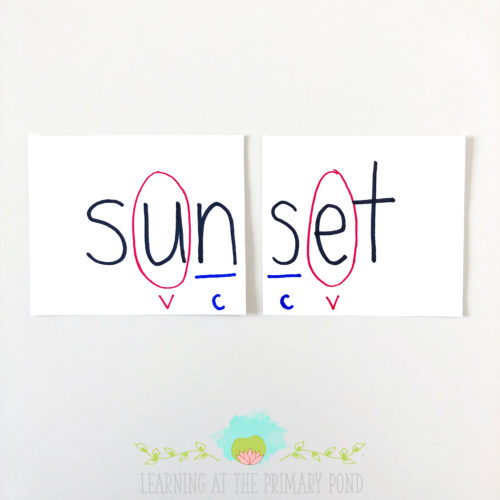
In the word “bathtub,” the vowel sounds are the short a and the short u. The two consonant SOUNDS in the middle are /th/ and /t/. The word gets divided up between the h and the second t.
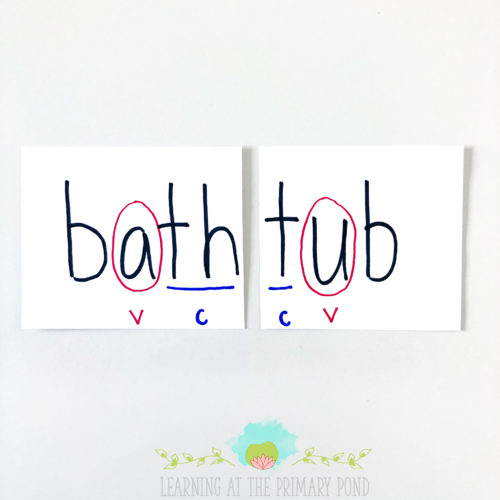
If there are 3 consonants between the vowels, rather than 2, there’s going to be a blend in there. The sounds that get blended together stay together in one syllable.
For example, in the word “complex,” we divide between the m and the p.
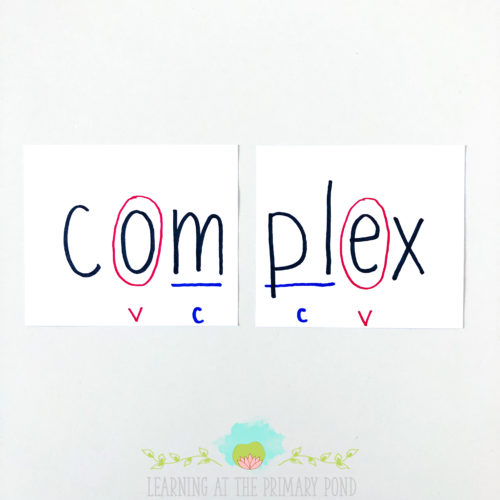
V/CV
Moving on…sometimes there’s just one consonant sound between the vowels, rather than 2.
If this is the case, the first syllable division rule that we try is V/CV (dividing up the word BEFORE the consonant).
For example, in the word “robot,” we divide up the word before the b. This creates an open syllable, “ro,” that ends in a vowel. As a result, the o in that syllable is a long o.
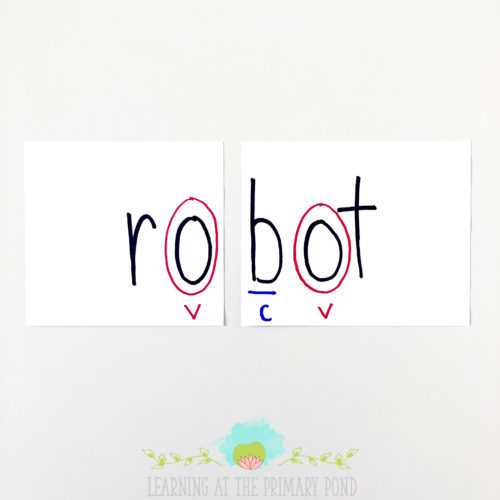
VC/V
However, sometimes the V/CV division rule doesn’t work. This is where it gets a little tricky.
If we try the V/CV rule but discover that it creates an open first syllable that should NOT be open (aka it should not have a long vowel sound), then we have to revert to the VC/V pattern.
For example, let’s think about the word “comet.” It’s pronounced with a short o at the beginning, right? It’s not CO-met. But if we were to apply the V/CV division pattern, that would make the o sound long. Instead, we have to revert to VC/V in order to reflect the fact that the o has the short o sound.
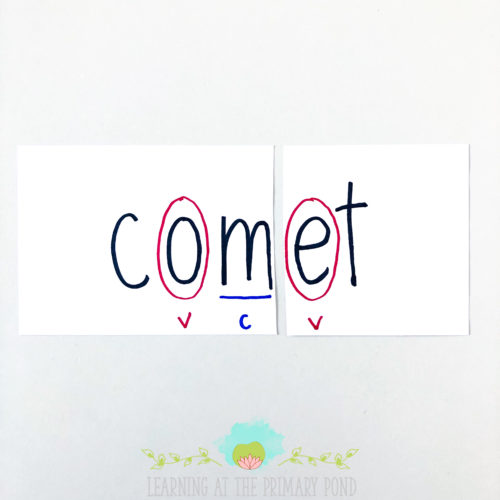
Another example is the word “seven:”
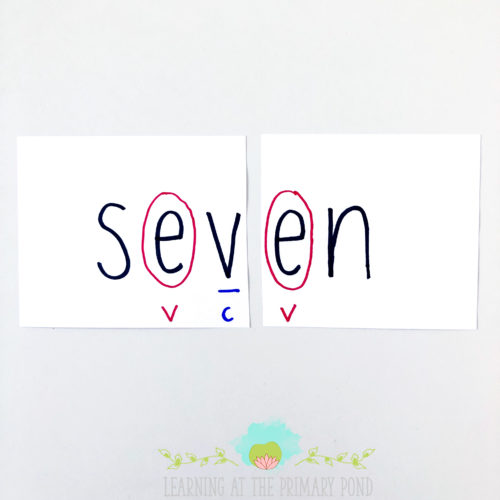
V/V
Last but not least, we have the V/V syllable division rule! When there are two vowels next to each other that do NOT work as a team, then we divide the word between those two separate vowel sounds.
For example, we divide the word “diet” between the i and the e:
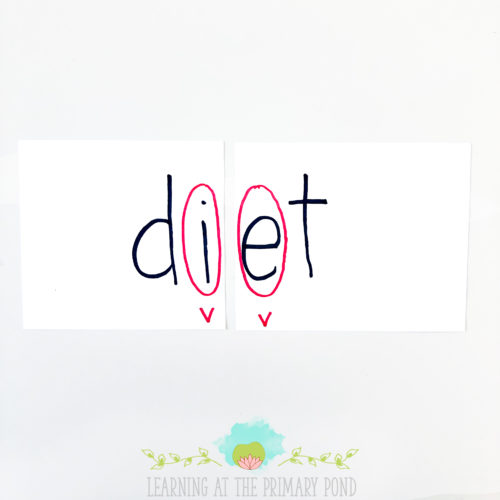
However, in a word like “coat,” we do NOT divide between the o and the a. There is only one vowel sound, the long o. Therefore, it’s a one-syllable word, and the o and the a work together to make a single sound. They cannot be divided up.
Tips for Teaching Syllable Division Rules to Students
Okay, so….that’s not too bad, right? Once you understand the four syllable division patterns, then you can teach them to your students!
As you probably noticed from the photos in this post, I have my students circle and label the vowels with red, underline and label the consonants with blue, and then cut or draw a line to divide the words. (Scroll back up through the photos in this post and have a closer look at what I did, if that helps.)
Here’s the procedure:
- Look at the word. Circle the vowel sounds with red.
- Underline the consonants BETWEEN the vowels (don’t worry about the other consonants).
- Determine which syllable division rule (VC/CV, V/CV, VC/V, or V/V) applies. (Students may have to attempt to read the word to choose between V/CV and VC/V.)
- Cut or mark the word accordingly.
- Read the word.
You can also have students code the syllable types after Step #3 (closed, open, VCE, vowel team, r-controlled, or CLE—read more about the syllable types HERE!)
When we’re learning about syllable division and syllable types, we use strips of paper. Students can copy a word I write on the board (or I prepare the word strips for them ahead of time).
I don’t read the word to them, because the purpose of the division exercise is to get them to break up the word and read it.
Once they’ve copied the word, then we go through Steps 1-5 listed above, and students can cut the word in half.
The ultimate goal of this exercise is to get students to break up multisyllabic words as they read. So, as a bridge between this activity and reading, we use whiteboards or sticky notes to divide up tricky words they encounter in texts.
If I’m working one-on-one with a student and he/she comes to a tricky word, we can write it on a small whiteboard and then break it up.
If students are working on their own, they can write a tricky word on a sticky note, divide it up, read it, and then continue reading.
This does slow down the reading process a little, but I’m telling you…kids feel SO powerful when they can break up words and determine what types of syllables they have. This process also makes it easier for students to figure out the vowel sounds in a word too.
When to Teach This Stuff
You might be wondering, “When should I teach these rules? At what developmental stage or grade level are these appropriate?”
When to teach the VC/CV rule:
Whenever kids have mastered CVC words, they can read 2-syllable words!
Simple compound words are a great place to start. You’ll want to use words like “sunset” and “pigpen” that are 2 CVC words “put together.” At this point, you can teach students the VC/CV rule. You can also explain that both of the syllables in those words are closed and have short vowels.
I don’t normally teach this in Kindergarten, but if I have more advanced students who are truly proficient with CVC words, then it makes sense to give them “access” to these simple 2-syllable words.
Of course, if you give students words with consonant digraphs or blends in between, then it becomes a little more complicated—early first grade may be a better time for those more complicated VC/CV words.
When to teach the V/CV and VC/V rules:
I teach the V/CV rule first, because we always try the V/CV pattern before reverting to VC/V.
You can teach this rule once students know about the long vowel sounds.
They don’t need to have completely mastered long vowels and all their spelling patterns. But they at least need to understand the concepts of open and closed syllables (and how short and long vowels relate to open and closed syllables).
When we’re working on the V/CV rule, I intentionally only give them practice words that follow that rule.
After they understand the V/CV rule, then I explain that sometimes we have to use the VC/V rule instead.
I then give them VC/V words to practice.
Finally, I give them mixed sets of words where they have to choose between V/CV and VC/V.
When to teach the V/V rules:
I wait to teach V/V until students really understand vowel teams and diphthongs.
If students don’t understand vowel teams, then they may try to divide up words like “train” into two syllables, between the a and the i. If they don’t understand diphthongs, they may try to divide up words like “loud” into two syllables.
Once they know the vowel teams and diphthongs, however, they’re more likely to recognize that words like “fluent” have two vowel sounds, not one, and we divide up the word accordingly (flu/ent).
Conclusions
This was a lot of info, right?! And it’s a lot to figure out and teach on your own – if you don’t have lesson plans and materials for it. Because unfortunately, many phonics and reading programs don’t cover this stuff!
If you’d like to make teaching this EASY and FUN for you and your students, check out my step-by-step guide to teaching all the syllable division rules and syllable types.
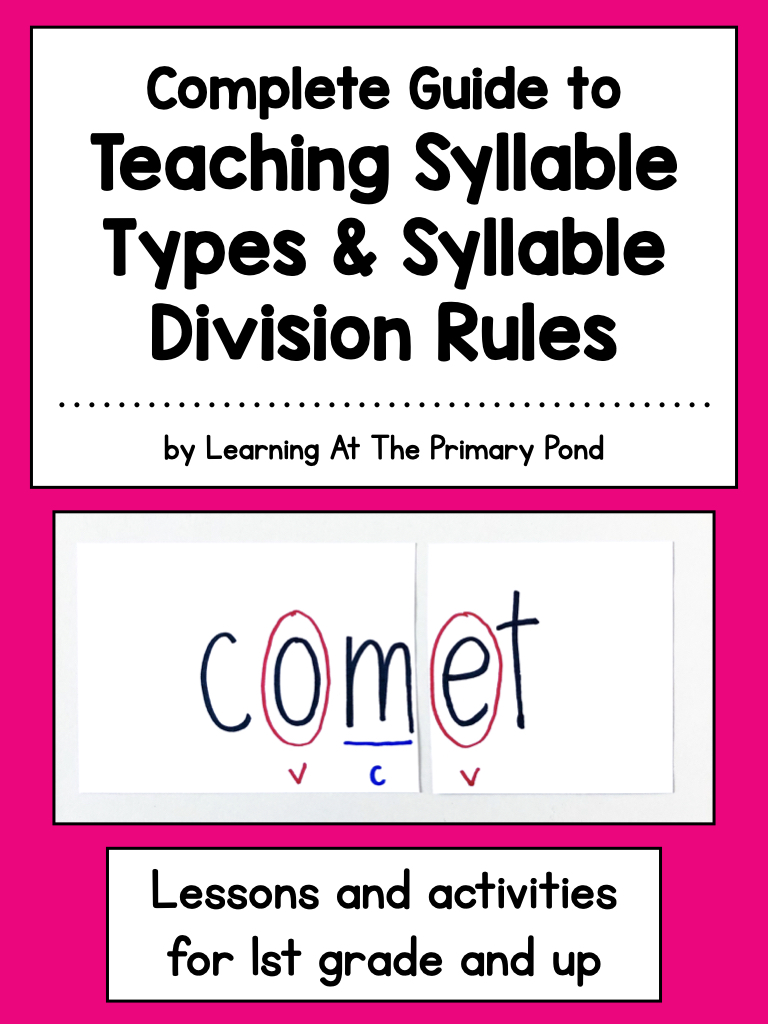
I designed this resource to fit perfectly into any phonics program. (However, if you’re using my phonics program, From Sounds to Spelling, you won’t need this resource because we cover this info within the program.)
You set the pace for how quickly you progress through these lessons! 1st grade teachers may spread them out throughout the entire school year, while 2nd grade and up may progress more quickly. Here’s page 1 of the table of contents (this is only half of the lessons):
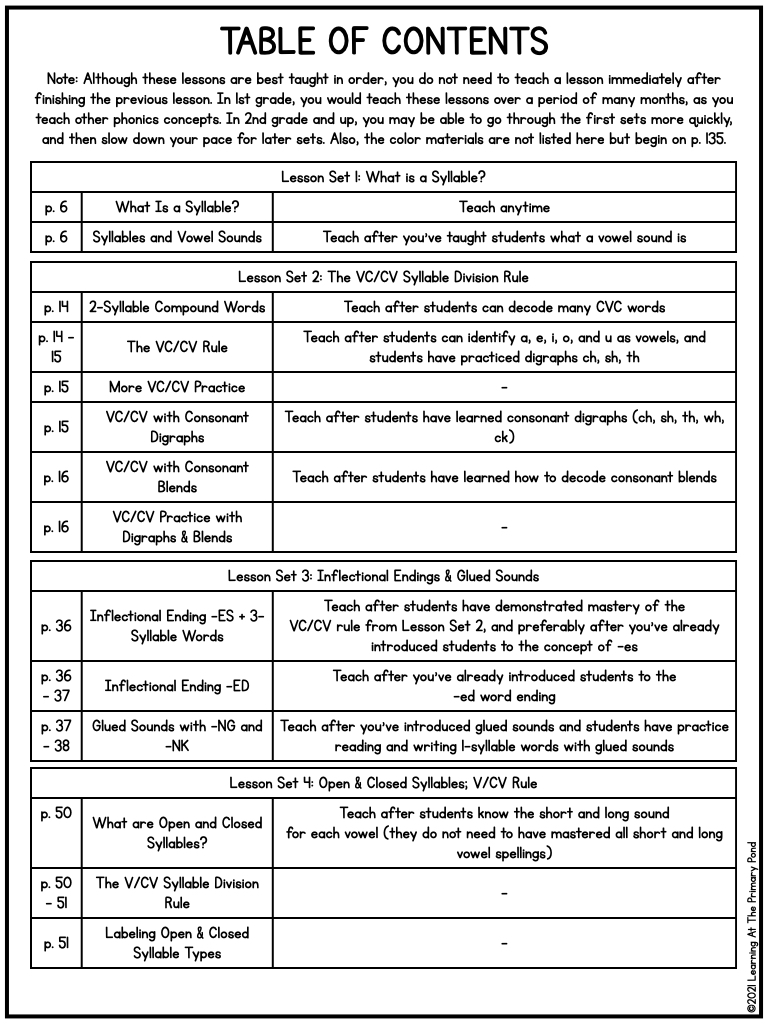
Here’s what a lesson plan looks like:
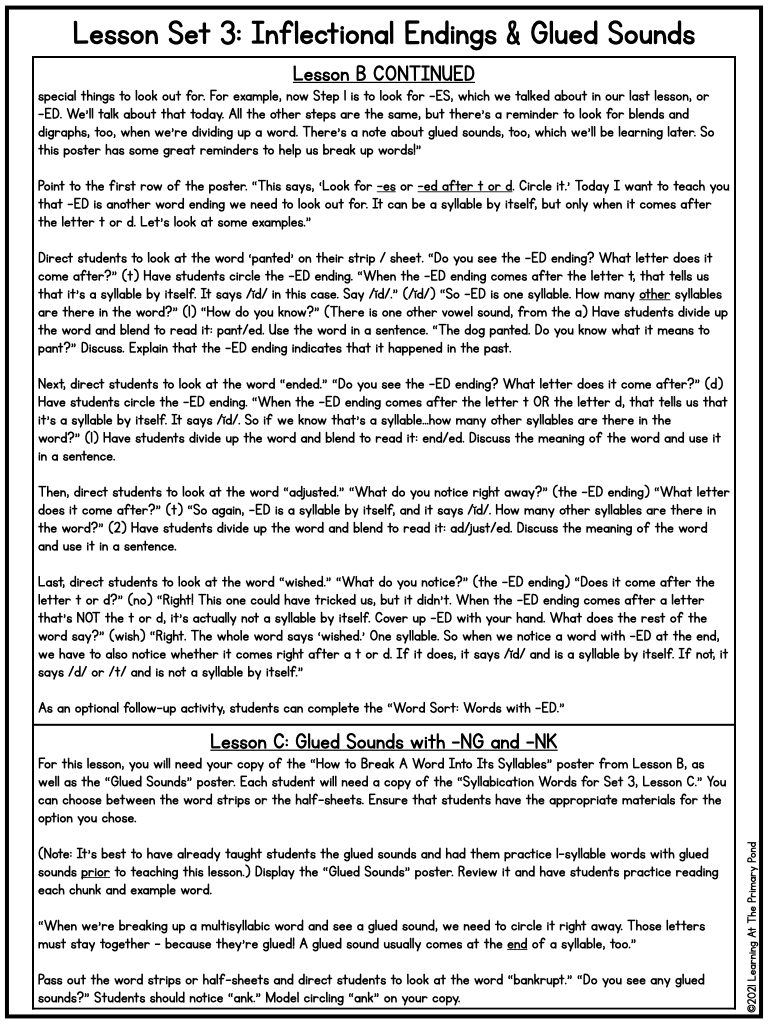
Also included are words to practice dividing, plus lots of hands-on games!
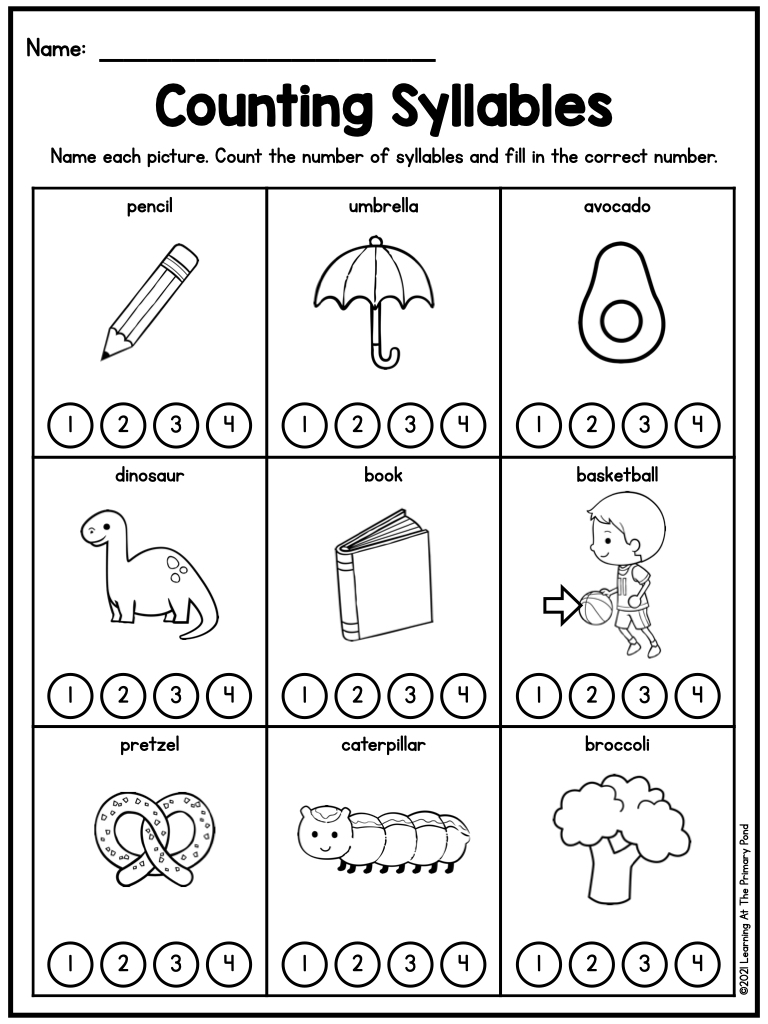

Everything is done for you, so you won’t have to invest time or energy in figuring all this out on your own and creating lessons!
However, if you already feel confident in teaching syllable division and have plenty of materials for it, you may just need a few practice activities for your students. If that’s the case, my digital practice games might be a better fit.
These activities give your students practice with dividing words up into syllables AND identifying syllable types. The games include audio directions that explain the syllable types and division rules!


I hope these resources are helpful to you! You can also pin this blog post to your Pinterest account so you can come back to it later:
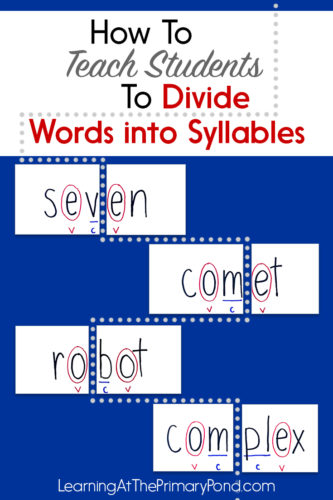
Happy teaching!
Related Posts:
There are 6 syllable divisions students should know. Before we get to the different types, let’s talk about why students should be able to identify these.
The truth is not all students NEED to know the different syllable divisions. I consider myself a very proficient reader and writer and do not recall ever being explicitly taught the different syllable divisions until I attended an Orton Gillingham training.
Understanding how to divide words into syllables helps students when they come across unfamiliar multisyllabic words. Knowing these strategies gives students the tools to properly decode ANY word! These rules are essential for dyslexic learners, but are valuable for all.

One of the most basic, but powerful, rules for students to remember is every syllable MUST have a vowel. Remembering this initial rule will help students as they start spelling more complicated words.
We are going to discuss 6 different syllable divisions. Each syllable division has been given an animal name, which aligns with the Orton Gillingham training I received. The animal name follows the syllable division rule, which makes it easy for students to remember.
1. VC.CV / Rabbit Rule
Out of the six syllable divisions, the VC.CV syllable division is one of the easiest to teach and therefore is typically introduced first. It stands for vowel-consonant-consonant-vowel. This rule states that if two consonants are between two vowels, you divide the word between the consonants.

Examples:
1. rabbit: There are two consonants (b and b) between two vowels (a and i), so we will divide the word between the consonants. The first syllable is rab and the second syllable is bit: rab/bit
2. muffin: There are two consonants (f and f) between two vowels (u and i), so we will divide the word between the consonants. The first syllable is muf and the second syllable is fin: muf/fin
3. tadpole: There are two consonants (d and p) between two vowels (a and o), so we will divide the word between the consonants. The first syllable is tad and the second syllable is pole: tad/ple
You can find more details about this syllable division and how to teach it HERE.
2. V.CV / Tiger Rule
The next two syllables should be taught together (tiger and camel). Both divisions include a VCV (vowel-consonsant-vowel) pattern.
For tiger, students will divide the word after the first vowel to make an open syllable.
Examples:
1. tiger: There is one consonant (g) between two vowels (i and e), so we will divide the word after the vowel to make an open syllable. The first syllable is ti and the second syllable is ger: ti/ger
2. remote: There is one consonant (m) between two vowels (e and o), so we will divide the word after the vowel to make an open syllable. The first syllable is re and the second syllable is mote: re/mote
3. hotel: There is one consonant (t) between two vowels (o and e), so we will divide the word after the vowel to make an open syllable. The first syllable is ho and the second syllable is tel: ho/tel

3. VC.V / Camel Rule
As previously stated, this syllable division also includes a VCV (vowel-consonsant-vowel) pattern and should be taught in conjunction with the tiger rule.
For camel, students will divide the word after the consonant to make a closed syllable.
Students should always be taught to try the tiger rule first. I like to ask my students “which animal is stronger: a tiger or a camel?” They think it is a funny question and always quickly say “tiger!” I tell them this is why they must try the tiger rule first; the tiger usually wins! 75% of the time a VCV word will divide after the first vowel, making it a tiger word.
Examples:
1. camel: There is one consonant (m) between two vowels (a and e). First we try dividing the word after the first vowel. This would leave me with my first syllable being “ca” and my second syllable being “mel.” I know ca-mel is not a word, so I would then try dividing after the consonant. This leads me to my first syllable being cam and second syllable being el. Cam-el is a word I know: cam/el
2. panic: There is one consonant (n) between two vowels (a and i). First we try dividing the word after the first vowel. This would leave me with my first syllable being “pa” and my second syllable being “nic.” I know pa-nic is not a word, so I would then try dividing after the consonant. This leads me to my first syllable being pan and second syllable being ic. Pan-ic is a word I know: pan/ic
3. robin: There is one consonant (n) between two vowels (o and i). First we try dividing the word after the first vowel. This would leave me with my first syllable being “ro” and my second syllable being “bin.” I know ro-bin is not a word, so I would then try dividing after the consonant. This leads me to my first syllable being rob and second syllable being in. Rob-in is a word I know: rob/in

4. VCCCV / Panther Rule
The VCCCV syllable division can be a bit more challenging for kids. Typically, we will divide words with three consonants between two vowels after the first consonant. Students should be taught to always keep blends and digraphs together, which will occasionally mean the word is divided after the second consonant (like in pumpkin and athlete).
Examples:
1. panther: There are three consonants (n, t, and h) between two vowels (a and e). I know “th” is a digraph, so I have to keep those letters together. This means I will divide after the first consonant. The first syllable is pan and the second syllable is ther: pan/ther
2. subtract: There are three consonants (b, t, and r) between two vowels (u and ). I know most of the time I will divide after the first consonant. The first syllable is sub and the second syllable is tract: sub/tract
3. athlete: There are three consonants (t, h, and l) between two vowels (a and e). I know “th” is a digraph, so I have to keep those letters together. This means I will divide after the second consonant. The first syllable is ath and the second syllable is lete: ath/lete

5. CLE / Turtle Rule
We know C.le (consonant “le”) is one of our six syllable types, but it can also be used with syllable division. For this rule, we teacher students that if a word ends in consonant “le,” we count back three letters then divide the word into two syllables.
Examples:
1. turtle: The word ends in a consonant (t) le. I count back 3 and divide the word before the consonant. The first syllable is tur and the second syllable is tle: tur/tle
2. apple: The word ends in a consonant (p) le. I count back 3 and divide the word before the consonant. The first syllable is ap and the second syllable is ple: ap/ple
3. giggle: The word ends in a consonant (g) le. I count back 3 and divide the word before the consonant. The first syllable is gig and the second syllable is gle: gig/gle

6. V.V / Lion Rule
The V.V syllable division (or sometimes called CV.VC) is not often taught, because there are few words that will follow this pattern. When students see two vowels next to each other that do NOT form a vowel team, the word should be divided between the vowels.
Examples:
1. lion: There are two vowels (i and o) and they do not form a vowel team, so we will divide between the vowels. The first syllable is li and the second syllable is on: li/on
2. giant: There are two vowels (i and a) and they do not form a vowel team, so we will divide between the vowels. The first syllable is gi and the second syllable is ant: gi/ant
3. ruin: There are two vowels (u and i) and they do not form a vowel team, so we will divide between the vowels. The first syllable is ru and the second syllable is in: ru/in

Teaching syllable divisions explicitly is crucial for helping students decode multi-syllablic words. It sets students up for success years to come. You can download my syllable division posters HERE.
